5 ITSM Automation Use Cases and Examples
IT teams are under greater pressure than ever before. With tightening budgets and exploding demand for services, almost all teams are considering strategies to build efficiency into their internal processes.
As a result, the need for effective ITSM automation has never been greater.
However, this is a broad, highly varied topic. That is ITSM workflows present a range of different challenges, many of which are suitable to distinct automation approaches.
Today, we’re diving deep by exploring the key use cases for ITSM automation, along with how we can implement them.
Specifically, we’ll be covering:
Let’s start with the basics.
What is ITSM automation?
ITSM automation means using software solutions to replicate and carry out elements within our service management processes that might otherwise require human actions.
The goal is to create efficient, scalable, and reliable processes by creating solutions to handle common tasks systematically.
Importantly, the scale of this can vary quite widely. So, some automations might only concern a single task, like transferring data from one platform to another, while others deal with end-to-end processes in a more wholesale manner.
As we’ll see a little later, this often means that different approaches to automation are suitable for specific use cases.
Another way of thinking about this is that automation means using software solutions to follow and enforce business rules and logic.
Often, this means mimicking existing logic and workflows, but we might also use automations to create new processes, as part of a wider improvement project.
Key ITSM workflows
To better understand the importance of ITSM automation, it’s worth considering some of the most prominent service management workflows. While it would be impossible to outline every single ITSM process, it’s important to understand the kinds of tasks ITSM teams handle.
This includes all aspects of how we provide colleagues with the IT tools, resources, and environment they need to do their jobs, as well as maintaining security, compliance, value for money, and other concerns.
Most organizations follow a defined framework for managing their IT services. These can vary, but they generally include workflows and processes under categories such as:
- Asset management - including managing hardware, software, and other assets.
- Ticketing, support, and helpdesk management - handling incoming support tickets for end users.
- Request management - processing requests from users for agreed services.
- Change management - ensuring changes to our IT environment are successfully implemented and documented.
- Knowledge management - documenting and surfacing knowledge relating to our IT estate.
- SLA management - ensuring service delivery complies with agreed standards.
- Incident and problem management - processing and resolving problems and incidents.
- Provisioning - providing end users with access to services and resources.
- Network and environment management - including maintaining the reliability of our IT environment.
- Compliance - ensuring IT processes comply with relevant legislation and regulations.
- Finance - managing the costs and value we derive from our IT services.
Within each of these, there are countless potential actions, workflows, and processes that will benefit from automation.
Later, we’ll explore some of the most prominent examples, along with how we can go about building them.
Benefits of automation
First, though, we can step back and consider why automation is such a priority for IT teams.
Among internal service departments, IT faces perhaps the greatest pressure to satisfy high demand and request volumes with often under-resourced teams.
Automation offers a clear path forward here. To understand how ITSM automation adds value, we can outline its core benefits.
These include:
- Efficiency - Enabling us to handle a greater volume of requests with fewer resources.
- Reliability - As workflows are triggered according to defined business rules.
- Consistency - Ensuring that all similar requests are always handled in the same way.
- Scalability - Automated solutions can be more easily scaled.
- Maintainability - We can modify automation solutions more easily than train colleagues on new processes.
- Error reduction - Including eliminating the scope for human error.
- Resolution times - ITSM automation can lead to faster resolution times.
- User experiences - Providing a better experience for end users and service delivery colleagues alike.
- Oversight and visibility - Ensuring a clear track record of actions is maintained.
On the whole, we can sum this up by saying ITSM automation enables us to reduce the amount of manual admin work that is required to deliver services. In turn, this means that our IT colleagues can spend time on more valuable tasks.
Challenges
Of course, this doesn’t mean that ITSM automation isn’t without its own challenges and limitations.
Indeed, as with any digital transformation initiative, it’s important to understand that our success is contingent on a range of technical, operational, and other factors.
So, in order to implement automation solutions that drive real value, we must be aware of the following challenges:
- Reflecting underlying business rules - Automation rules can only be effective if we’re able to accurately map the underlying business logic.
- Ineffective existing processes - If existing processes are unsuitable to begin with, automation may simply exacerbate this problem.
- Implementation costs - We’ll need to factor in the up-front and ongoing costs of implementing automations.
- Resistance to change - Many automation projects encounter resistance to change from colleagues or other stakeholders.
- Vendor lock-in - We risk becoming dependent on a single vendor for critical business processes.
- Security considerations - We must put measures in place to ensure automated processes remain secure.
- Auditability and oversight - Including monitoring automations to maintain performance and accuracy.
- Responding to change - As our needs change, we may need to adjust automation solutions to reflect this.
- Dealing with fringe cases - Deterministic automations will often struggle with unexpected inputs or scenarios.
None of these considerations are necessarily deal-breakers. Rather, what they highlight is the need to carefully choose appropriate approaches to automation to meet the requirements of our underlying use case.
We’ll examine this in more detail in the following section.
Types of automations
As we said earlier, automation involves using software tools to carry out tasks that might otherwise require human action. However, this is a relatively broad statement.
In reality, there are several different types of automations, each of which is suited to distinct types of tasks and workflows.
For the purposes of ITSM automation, the key options available to us include:
- Rule-based automation – Using if/then logic to trigger predefined actions based on known conditions.
- Workflow automation – Orchestrates a sequence of tasks across tools, systems, or teams.
- Scripting and macros – Lightweight scripts or command sequences to automate actions inside specific tools.
- Robotic Process Automation (RPA) – Mimicking human interactions with software UIs to automate rule-based tasks across legacy systems.
- AI-powered automation – Uses natural language processing, classification models, or generative AI to make decisions, understand context, or generate responses.
- Event-driven automation – Responds to system or monitoring events in real-time. For example, monitoring systems to identify incidents.
Each of these offers its own distinct pros, cons, challenges, and use cases. Additionally, some, like event-driven incident monitoring or RPA, are more reliant on dedicated solutions. Others, such as rule-based and workflow automations, can be built using a variety of methods.
These include workflow management platforms, no/low-code platforms, and hard-coded solutions, among others.
Which of these is suitable is often a case of balancing the complexity of our required solution with the technical skills and resources we have available for building it.
You might also like our guide to AI agentic workflows .
5 ITSM automation use cases and examples
With a strong grasp of what ITSM automation is, how it works, and what it achieves, we can begin to check out some specific examples.
We’ve chosen five of the most common examples of IT management tasks that can be easily automated for maximum impact.
For each one, we’ll be giving a short demonstration of how this can be built in Budibase. If you’d like to build along with us, sign up for a Budibase account below to create as many apps as you’d like.
Ticket categorization
Our first use case is ticket categorization. This relates to one of the biggest administrative time sinks across almost all IT teams. We can’t rely on users to accurately self-select categories for their tickets, but it’s also not a good use of service desk colleagues’ time to do so.
Luckily, with Budibase’s AI capabilities, it’s incredibly easy to handle this automatically.
To demonstrate, we’ve built a simple ticketing form that accepts a Title and Description.
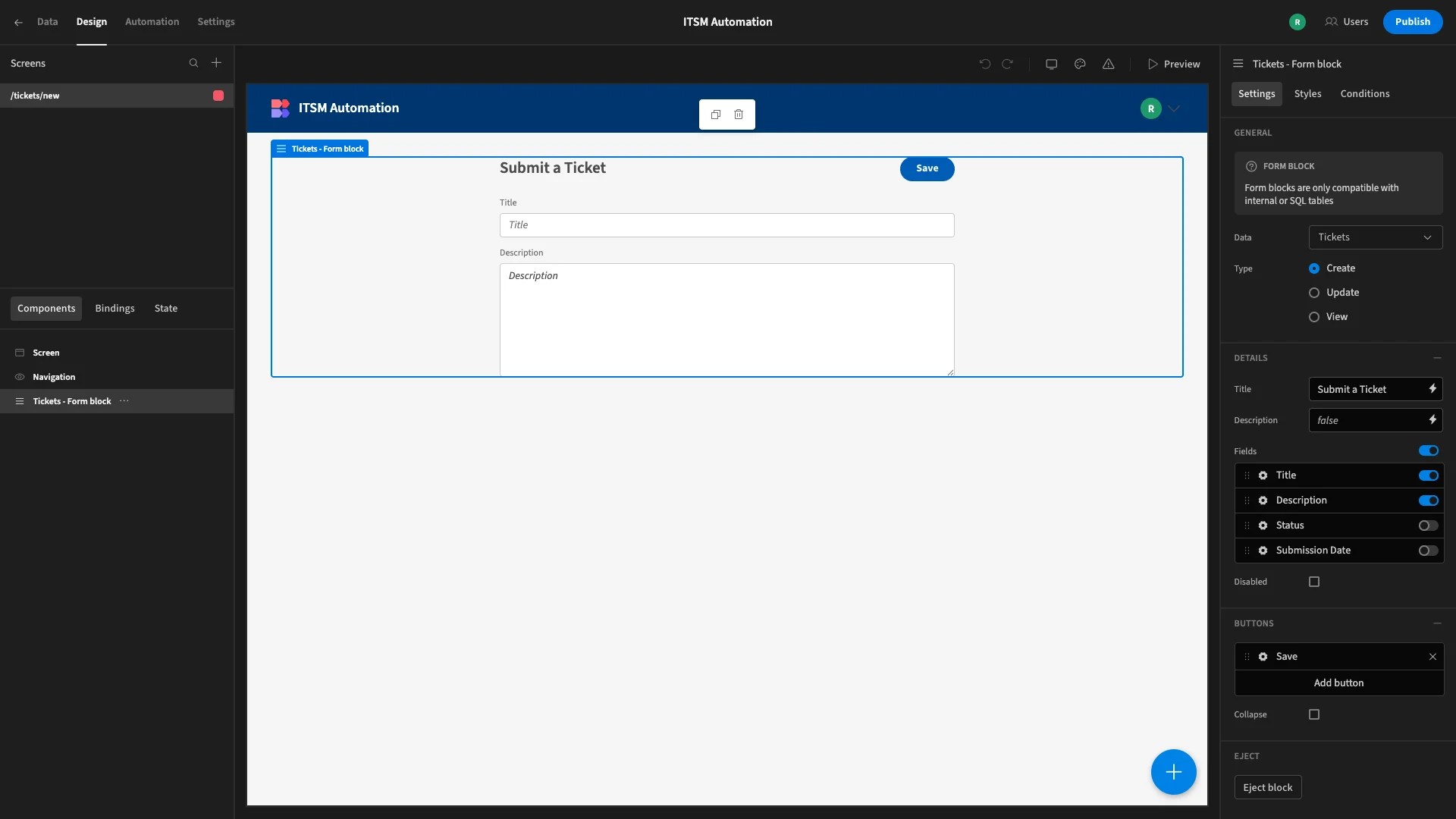
Rather than building a custom automation rule, we can set up auto-categorization in Budibase’s Data section.
Here’s what our underlying database table looks like. Only the Title and Description fields require user inputs. The other two columns are handled with default values.
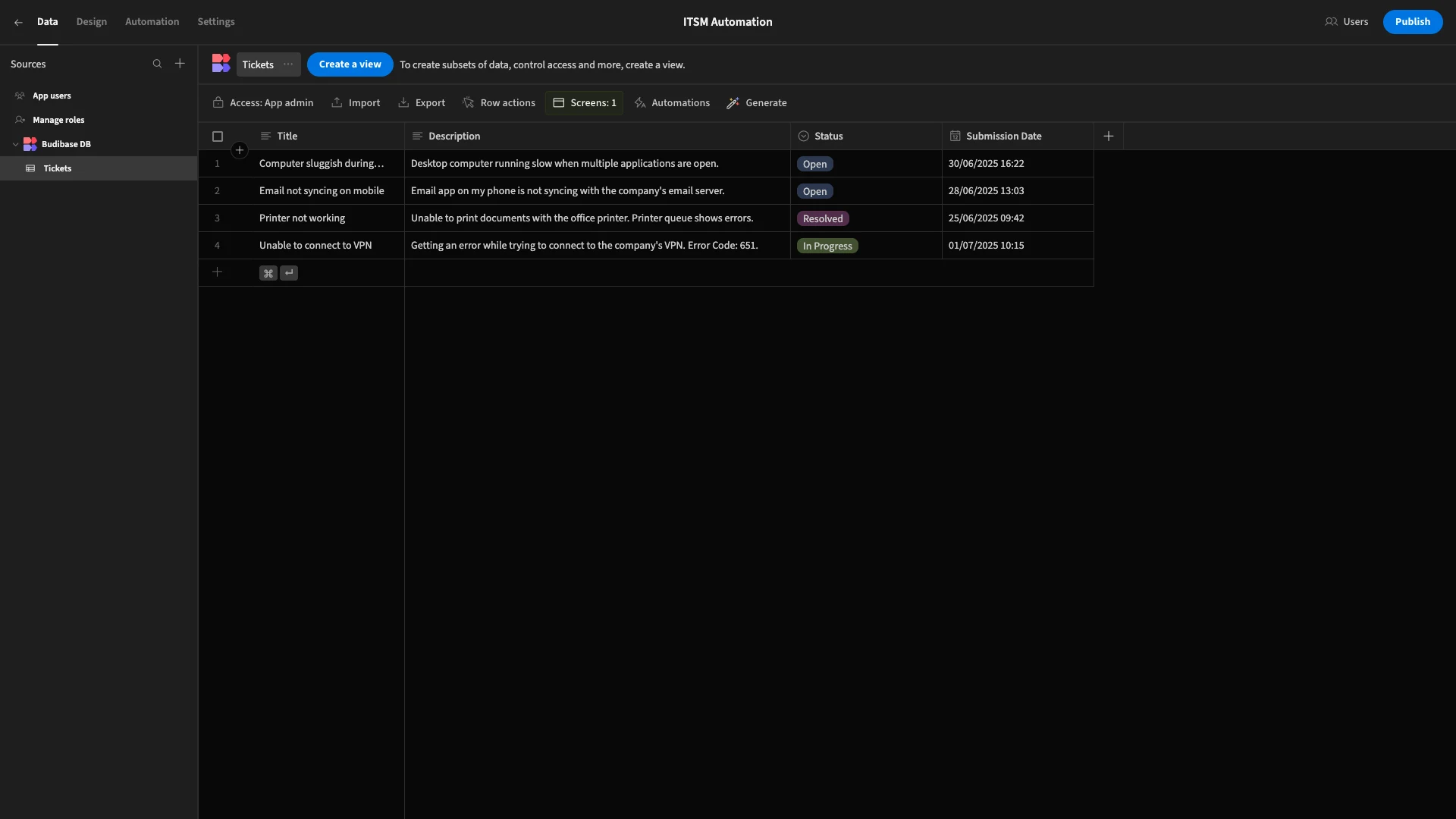
We’re going to categorize our ticket submissions using BudibaseDB’s AI column. We’ll use the + icon to add a new column, choosing AI as our data type. We’ll call this Category.
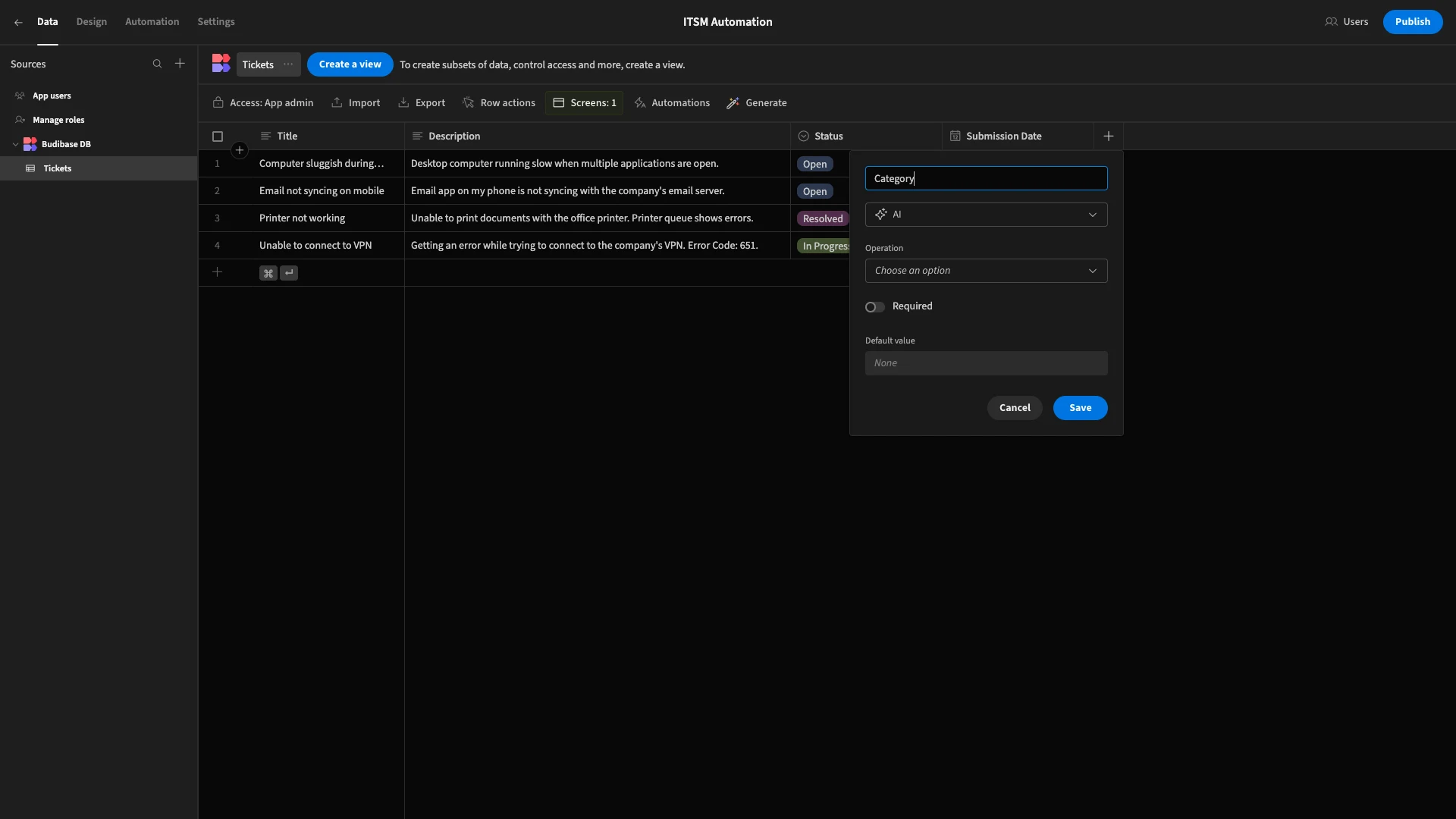
We have a choice of Operations. These are pre-configured prompts that we can use to carry out specific tasks using our data. We’re choosing Categorise Text.
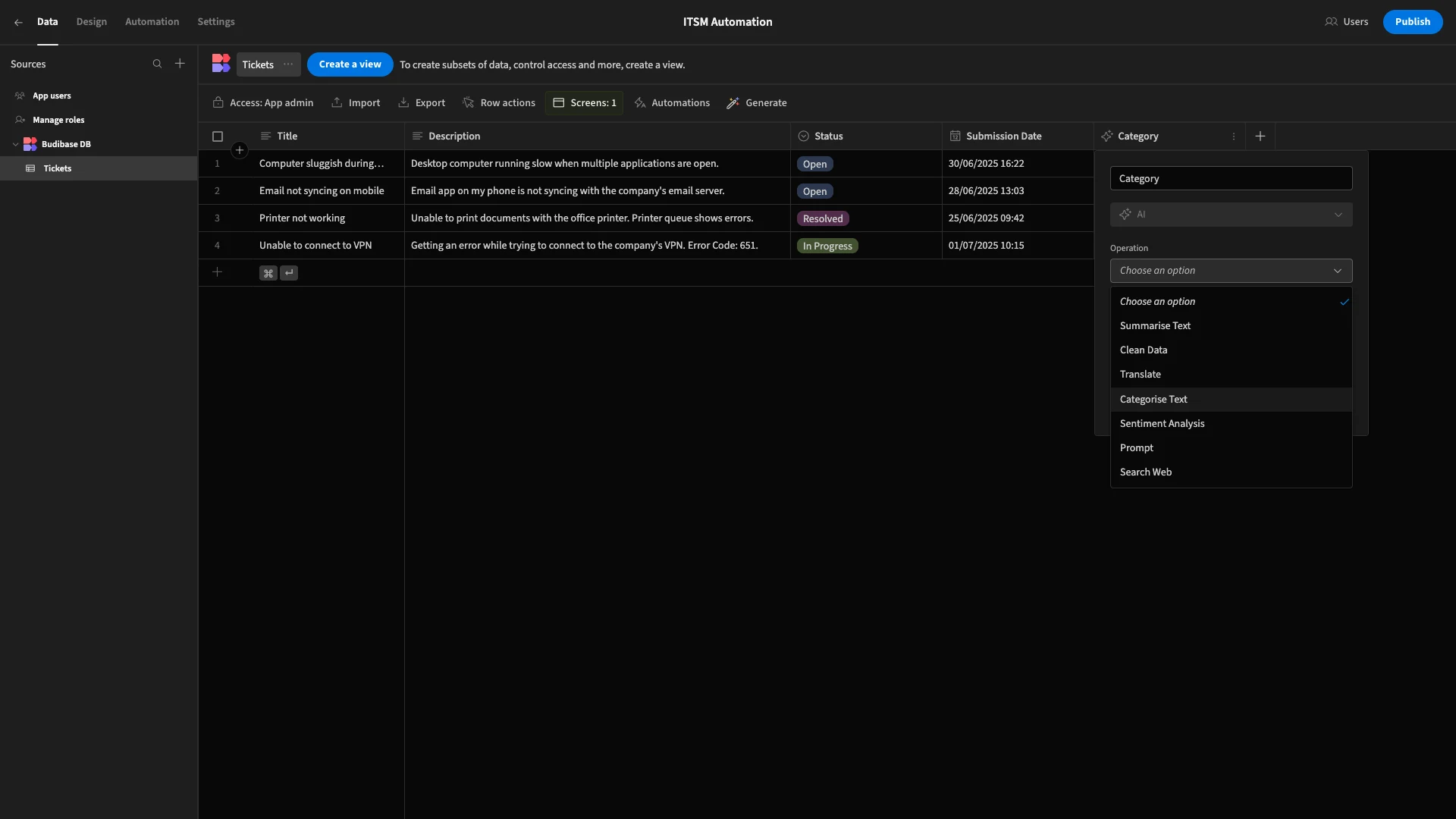
When we choose this option, we’re offered two fields for setting the columns we’d like to target and the categories we want to specify.
We’re choosing the Title and Description columns.
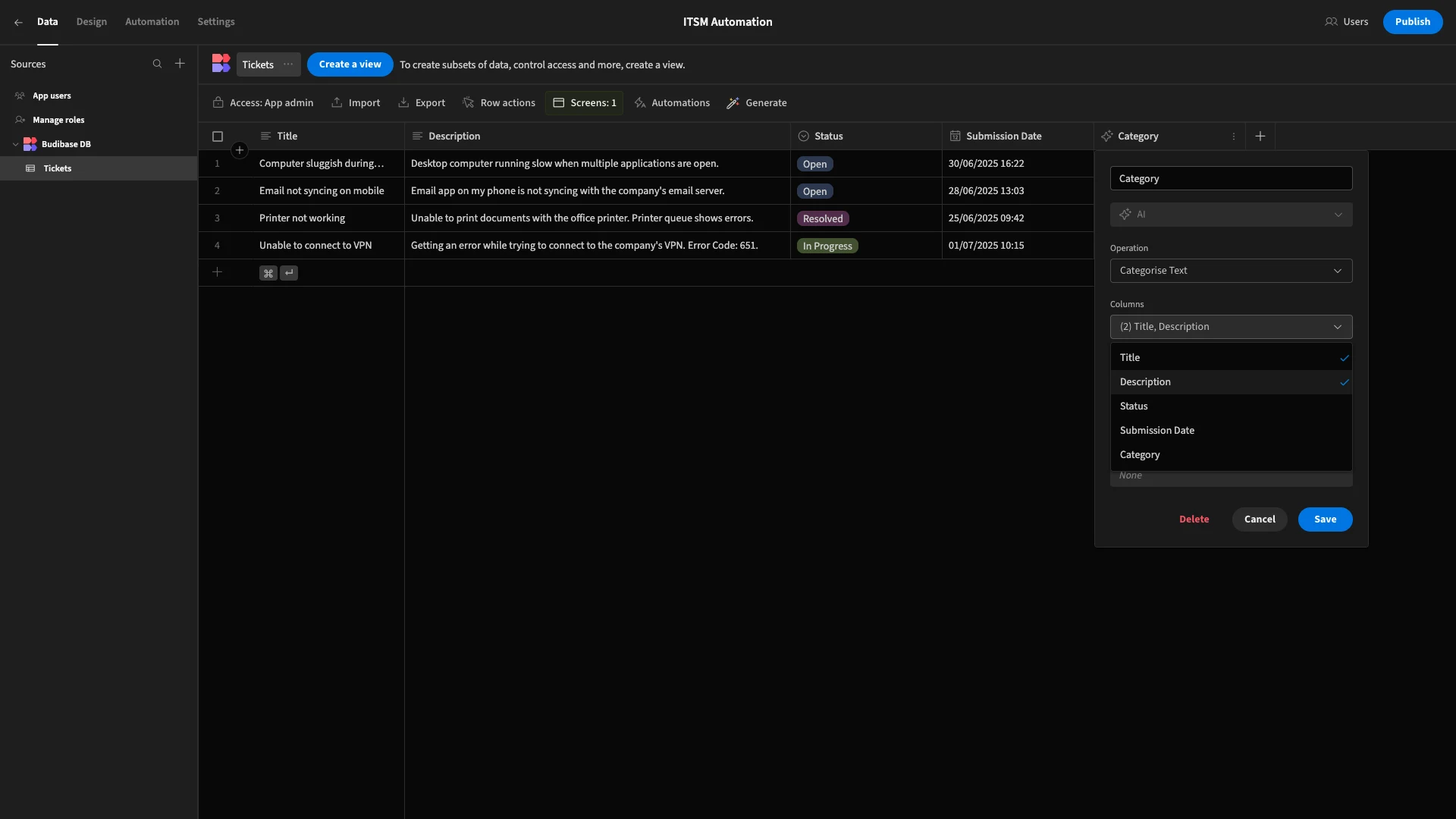
Next, we’ll hit the lightning bolt icon alongside the Categories field.
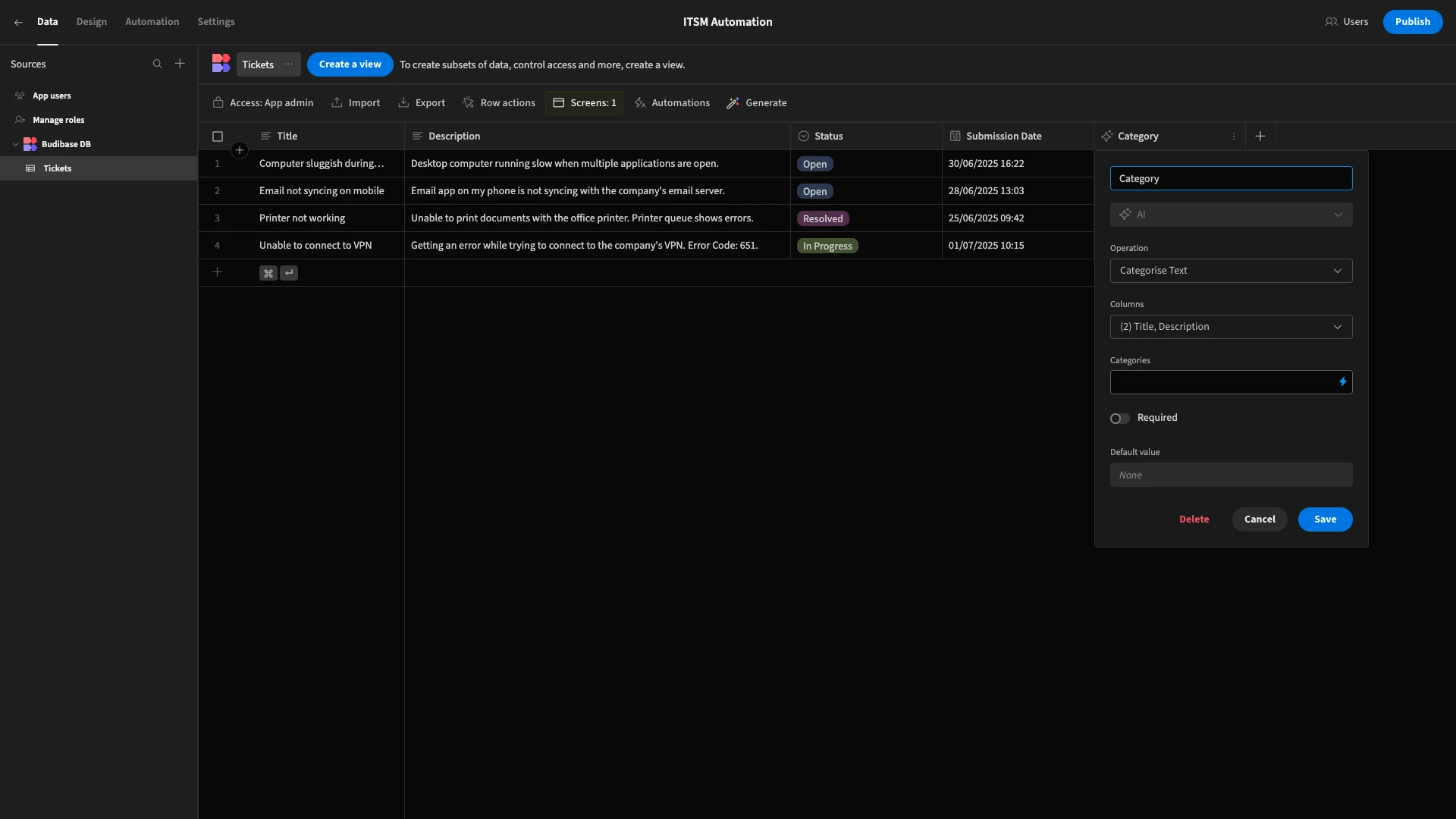
Here, we can add comma-separated values. We’re choosing Hardware, Software, Network, Security, and Other.
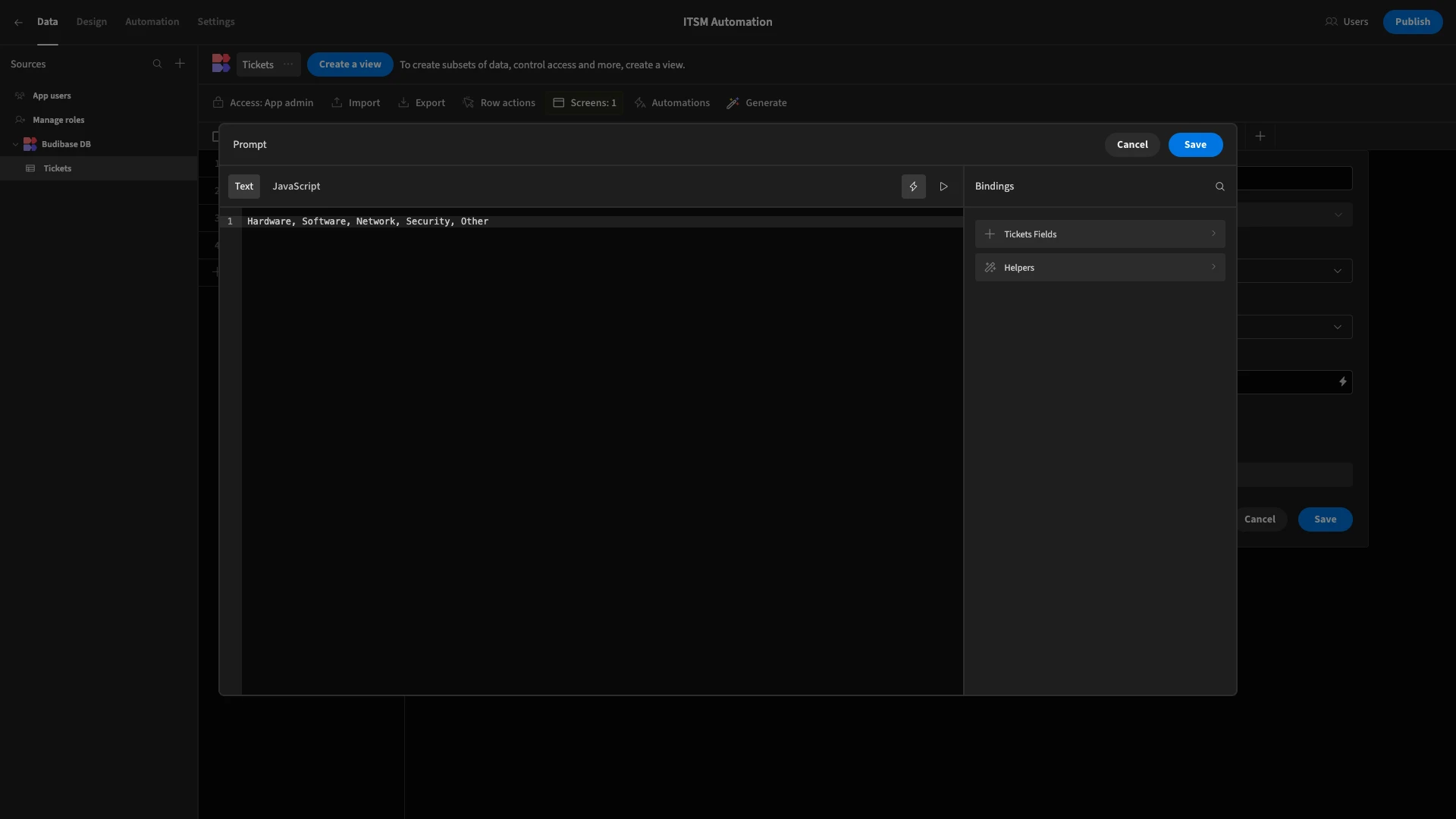
Now, we’ll head back to our ticketing form UI and add a row to test this out.
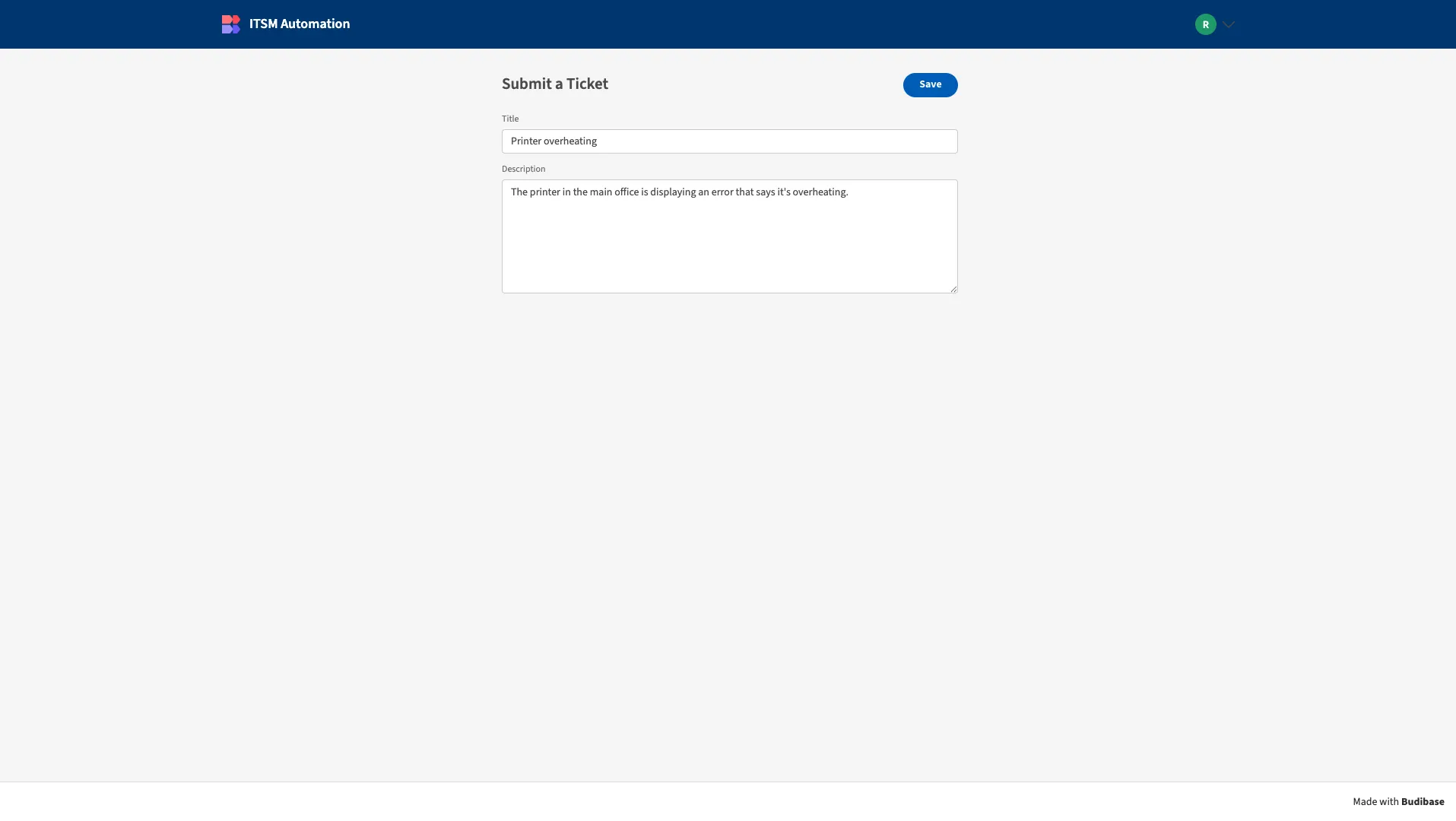
Back in the data section, we can see that this has been successfully categorized as Hardware.
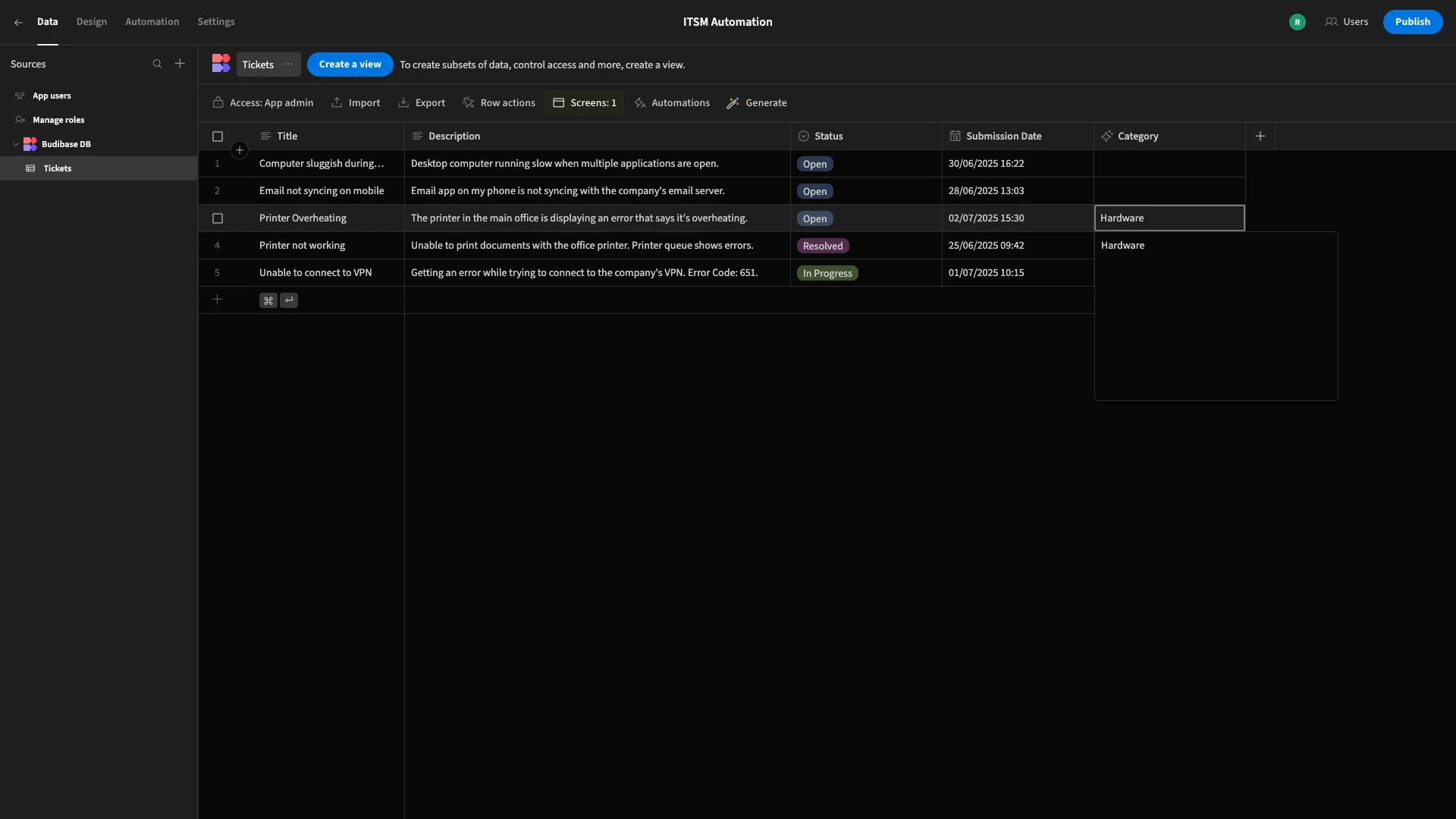
Incident triage
The next ITSM automation use case we’ll explore is triaging incident reports. Triaging incidents means determining what category they fall into, as well as how we should prioritize them. That way, we can determine which actions are required to resolve the underlying issue.
This time, we want to use AI to select the appropriate values for our category and priority, but this time we want these formatted as a JSON object. That way, we can then use these for downstream processing.
Once again, we’re starting with a light-weight incident report form with Title and Description fields. Of course, in the real world, our form would likely be more complex, but we’re keeping things simple for demo purposes.
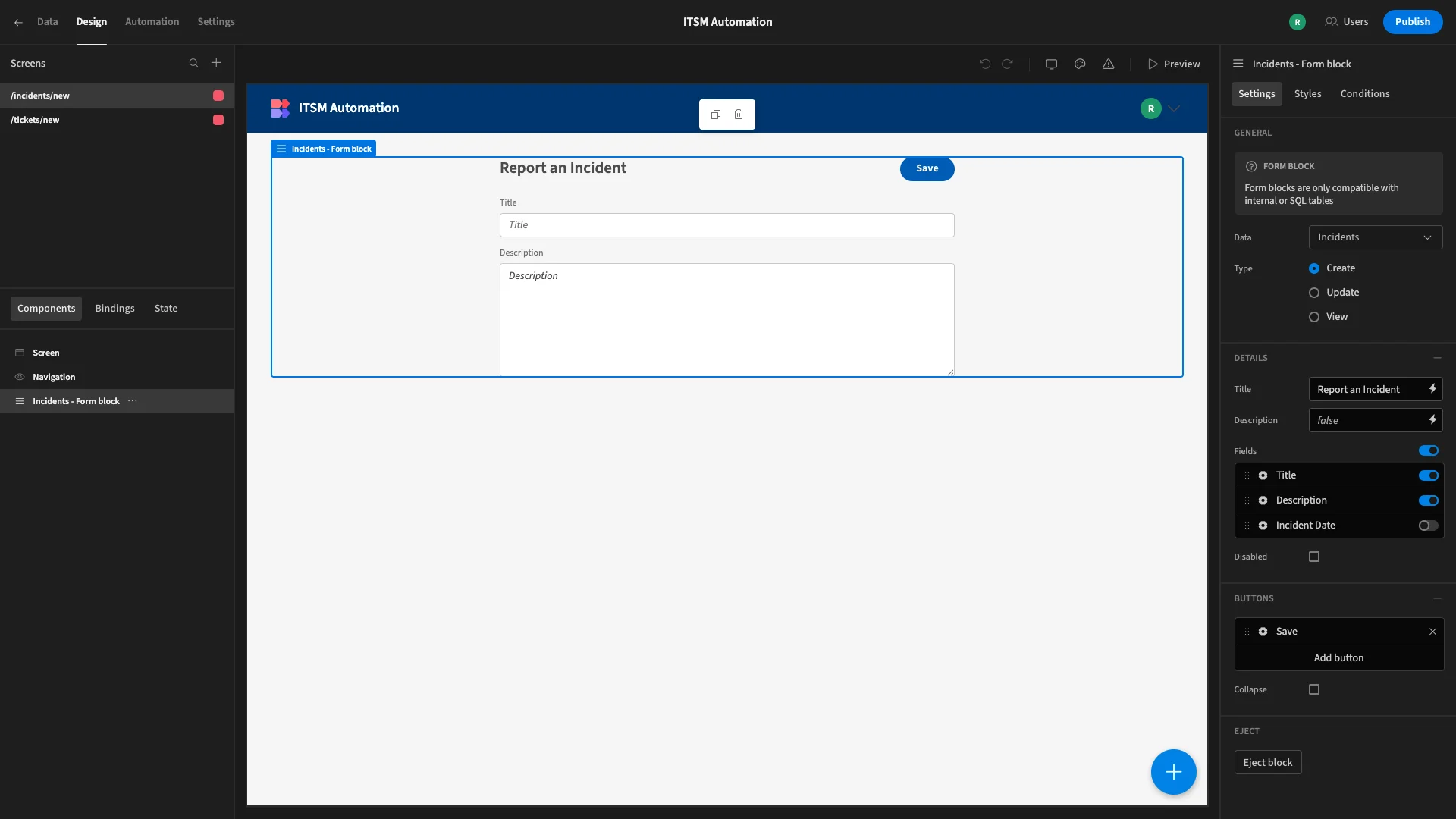
Like before, we’re going to start by adding an AI column to our database table. This time, we’re calling it Triage and choosing Prompt as our operation.
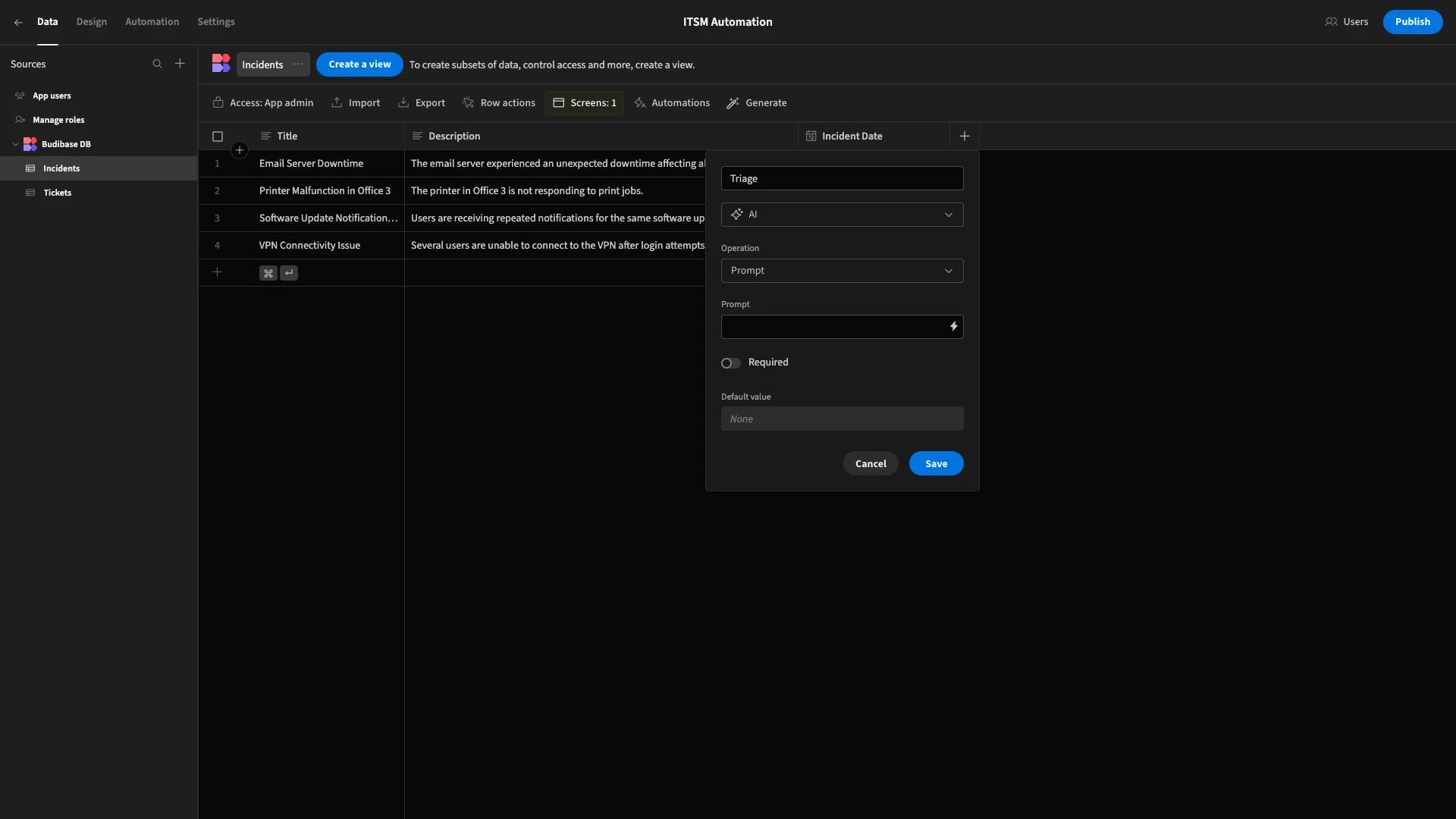
Again, we’ll use the lightning bolt icon to open the modal screen where we can enter our prompt.
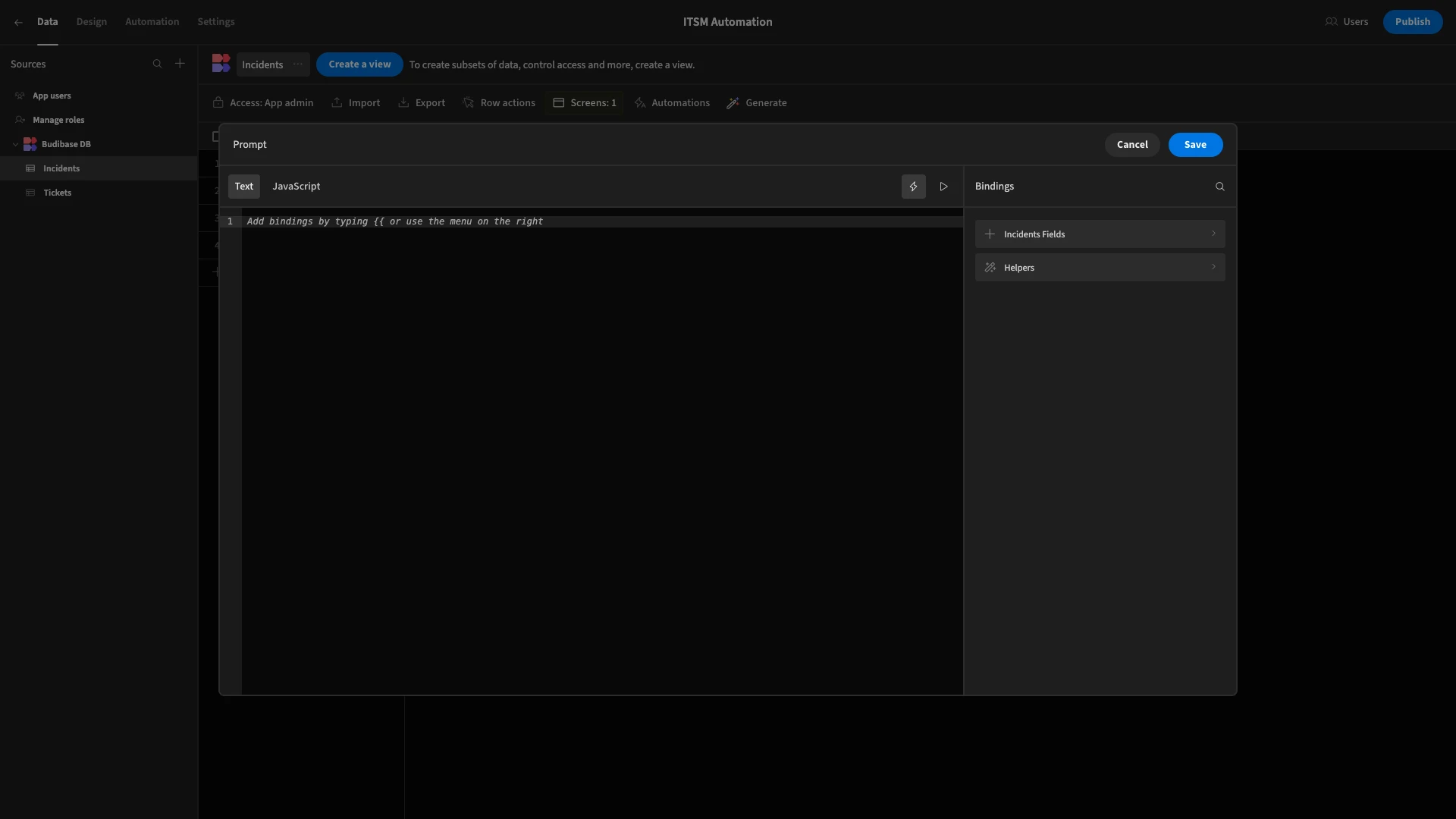
We need to write a prompt that will send our incident form submissions to the AI model, specify the values we need, and provide the format we want this returned in.
We can achieve this with the following prompt.
1The following is an IT incident report:
2
3{{ Title }}
4
5{{ Description }}
6
7Please use this information to determine a category:
8
9Hardware, Software, Network, Security, Other.
10
11Also provide a priortiy:
12
13High, Medium, Low, Urgent.
14
15Return this information as JSON object in the format:
16
17{
18
19"Category": "Hardware",
20
21"Priority": "High"
22
23}Of course, we’d likely provide more detailed business rules for how to determine values for each of these in a real-world solution.
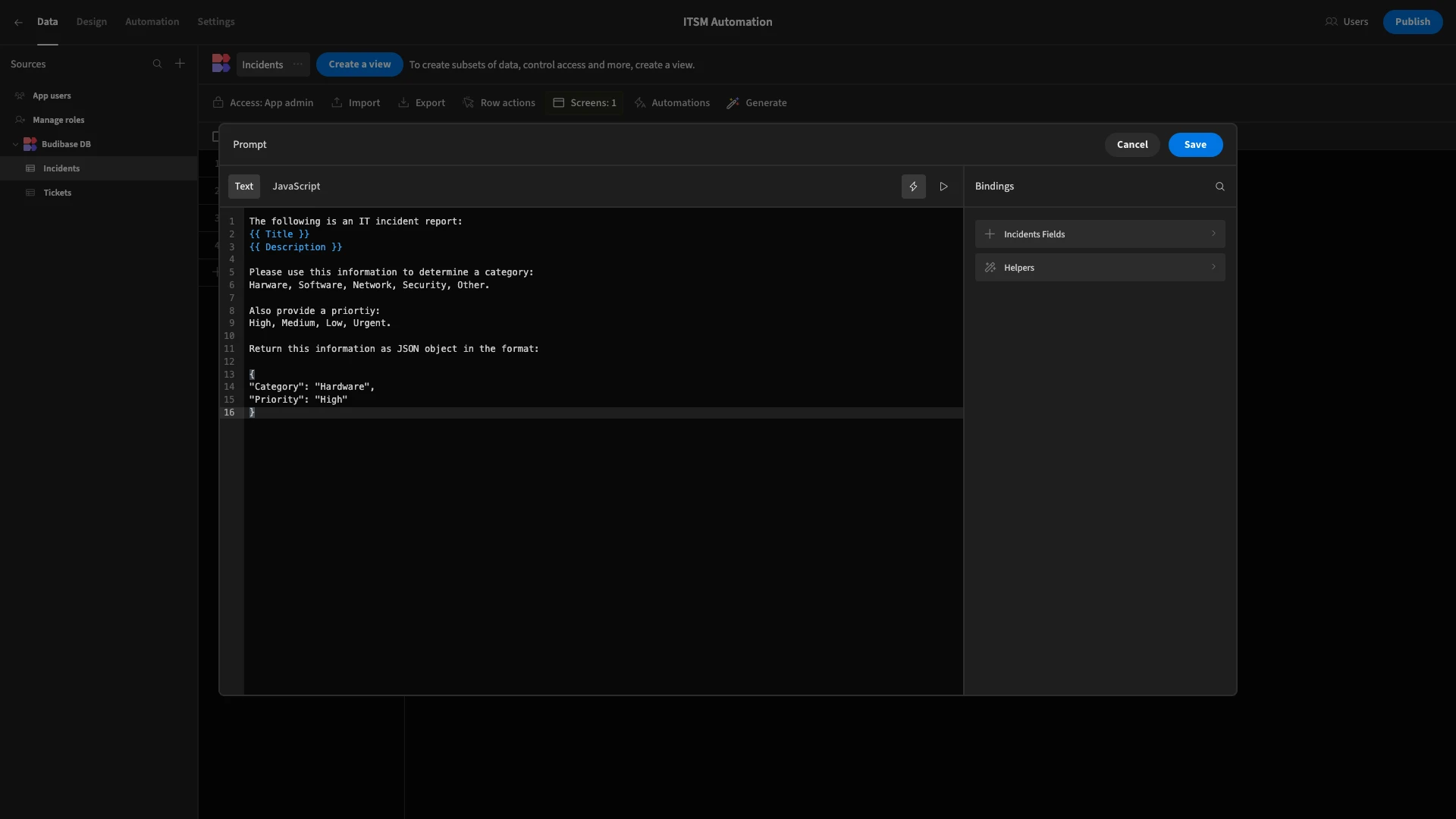
Again, we’ll test this out by submitting some dummy data.
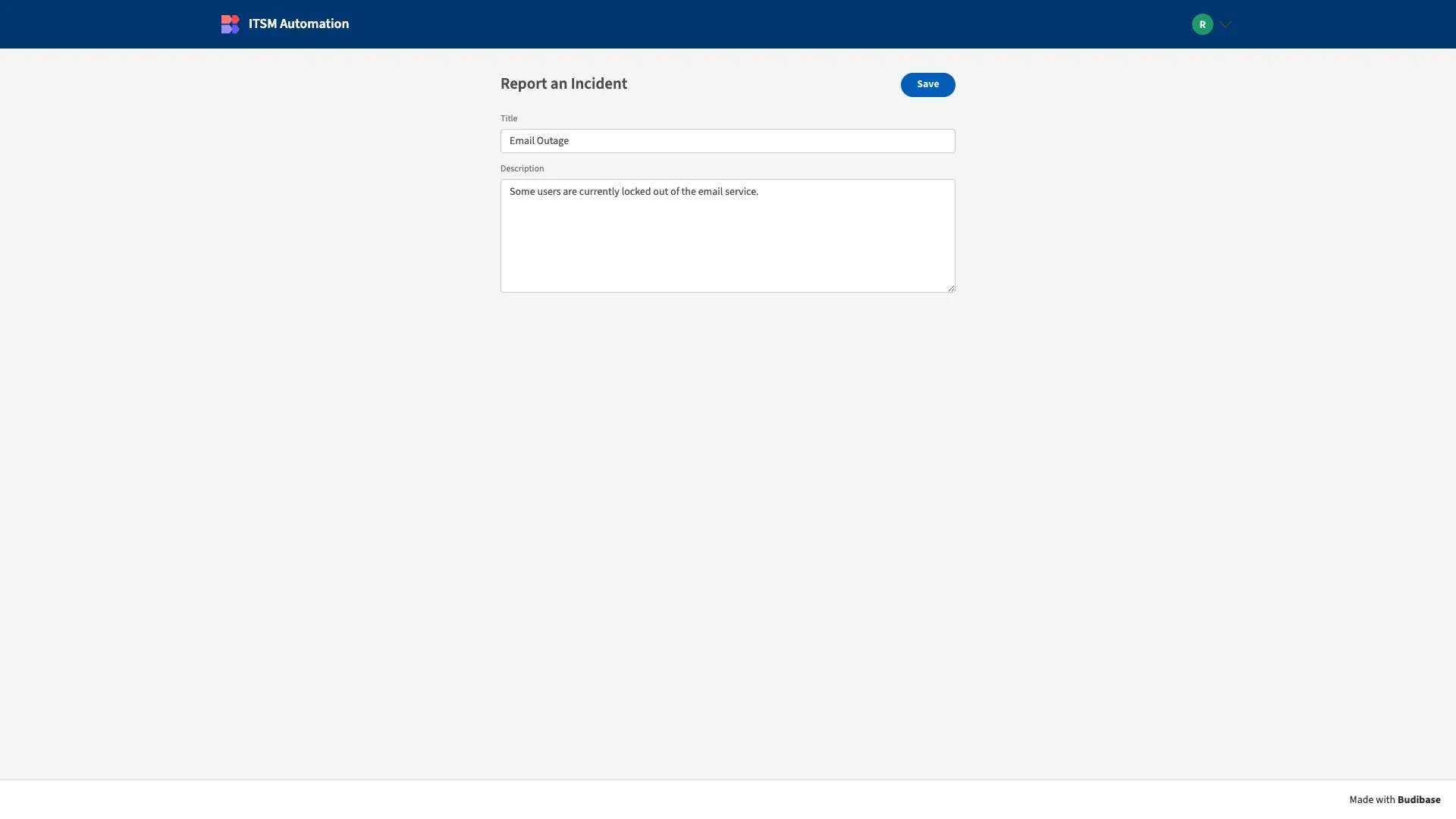
And we can see that the AI column has been successfully populated.
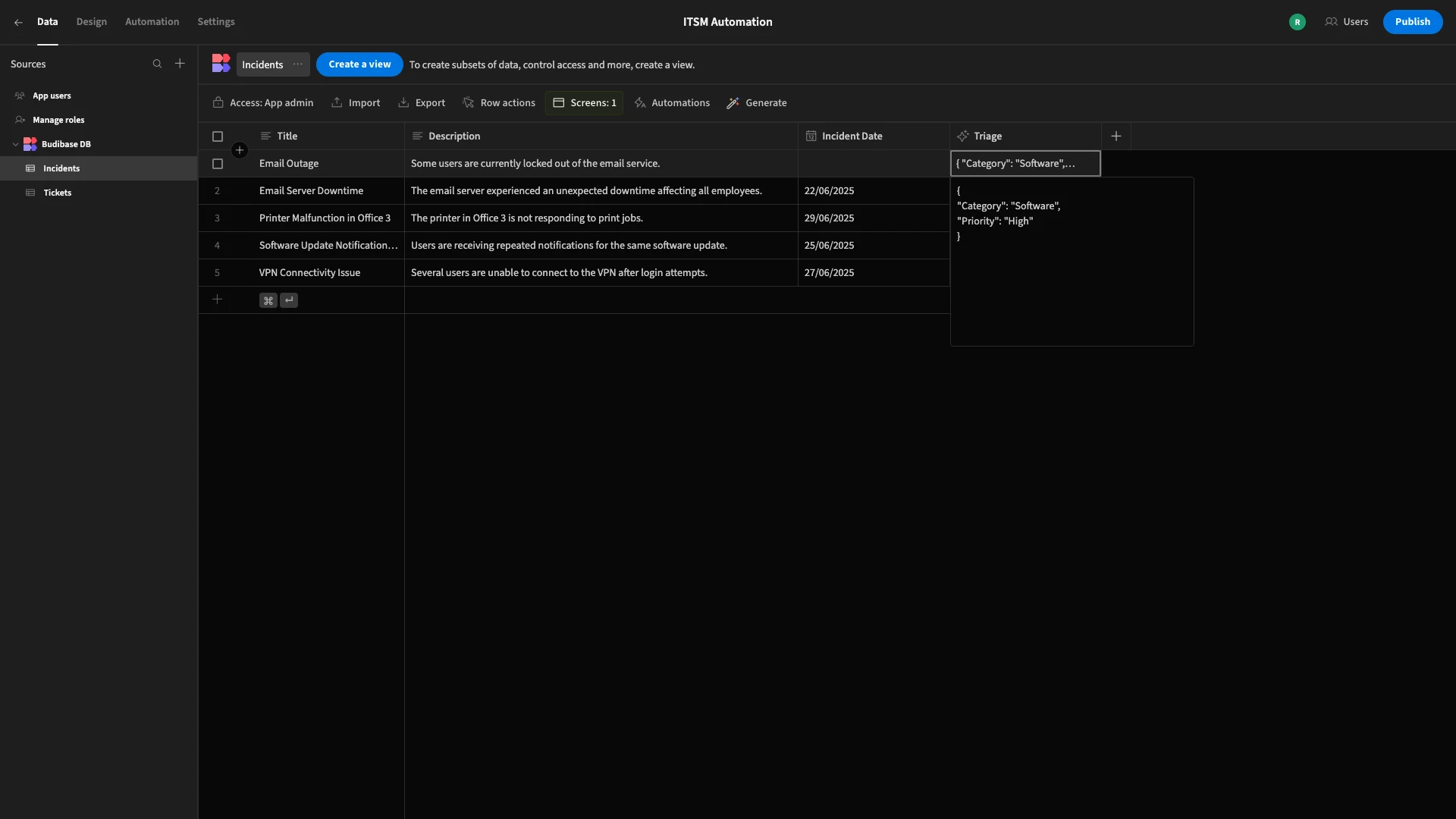
Time-based notifications
Many of the most common ITSM automation use time-based rules to trigger defined actions. This can mean that a workflow executes at fixed times, or at a specified interval after another event.
An example of the former would be generating a particular report on a weekly basis.
For our example, we want to create a time-based rule that will run every Monday, and highlight any tickets that were submitted in the past week and remain open. These can then be prioritized by service delivery colleagues.
This time, we’re starting with our tickets table from earlier, but we’re more focused on the Status and Date Submitted attributes.
We’ll head to the Automation section, where we’re prompted to create a new automation.
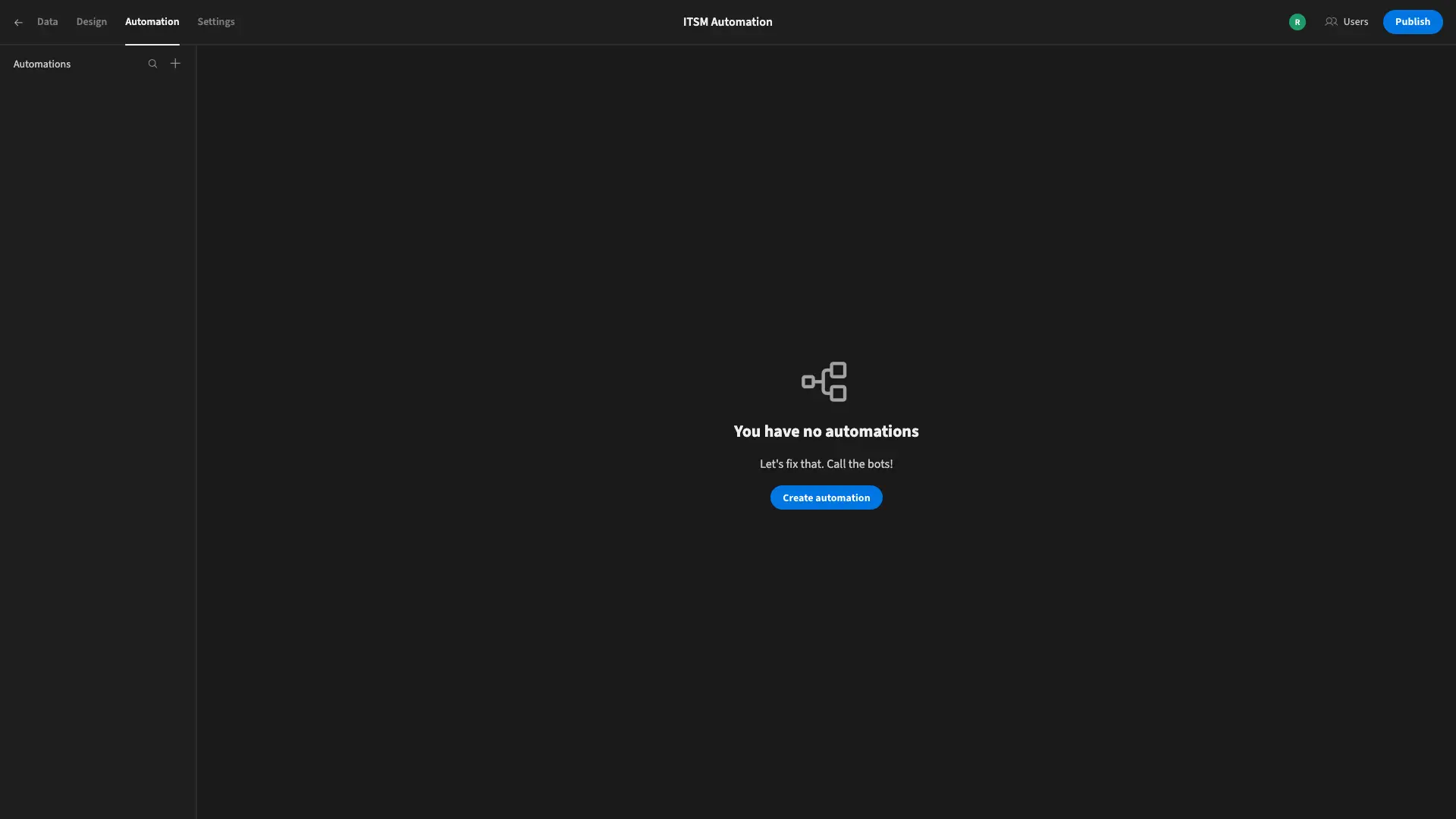
When we hit this button, we’re asked to give our new automation rule a name and choose a trigger. We’re calling ours Reminder and selecting the CRON/Schedule trigger.
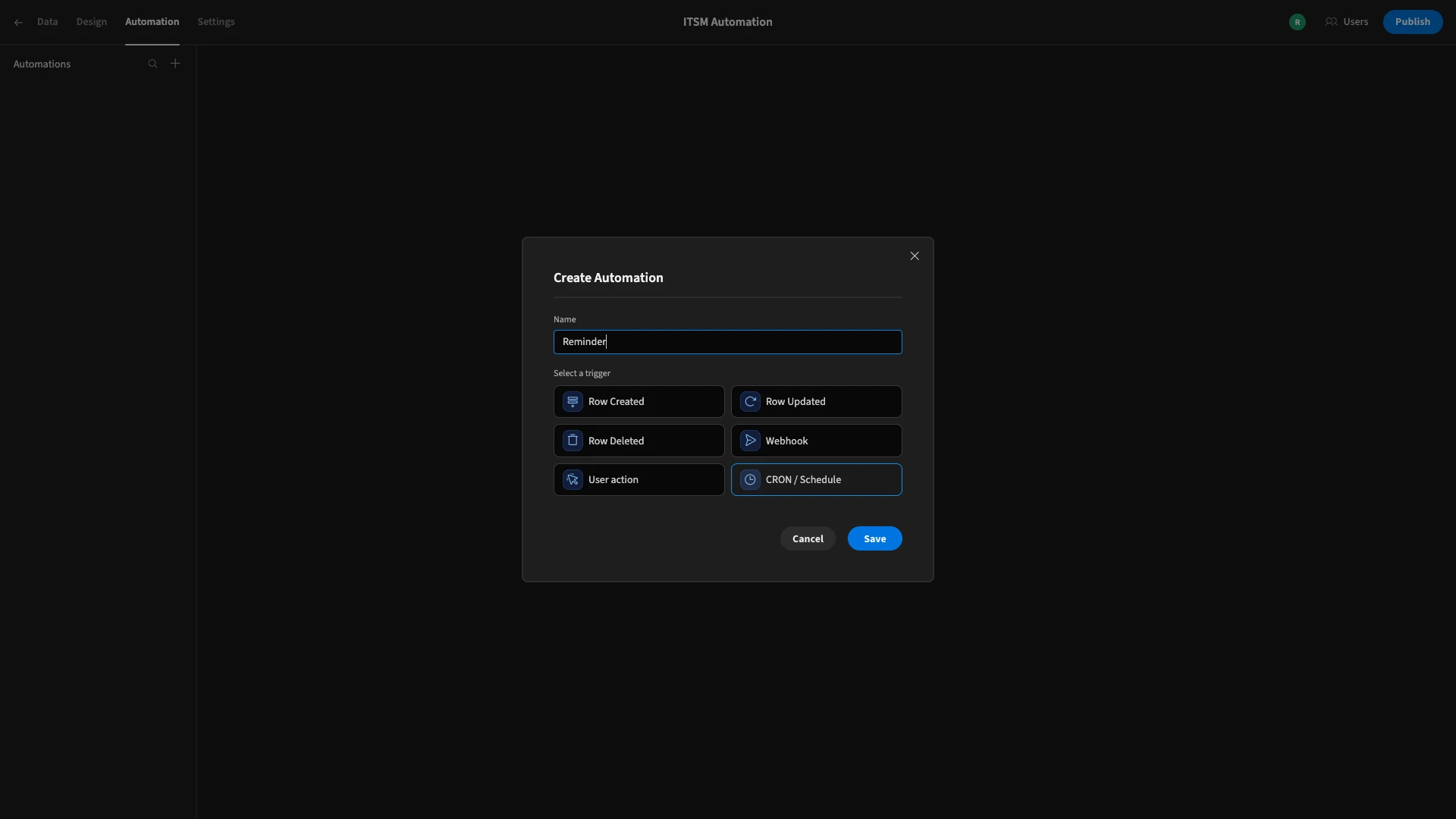
To configure our trigger, we need to set a CRON expression.
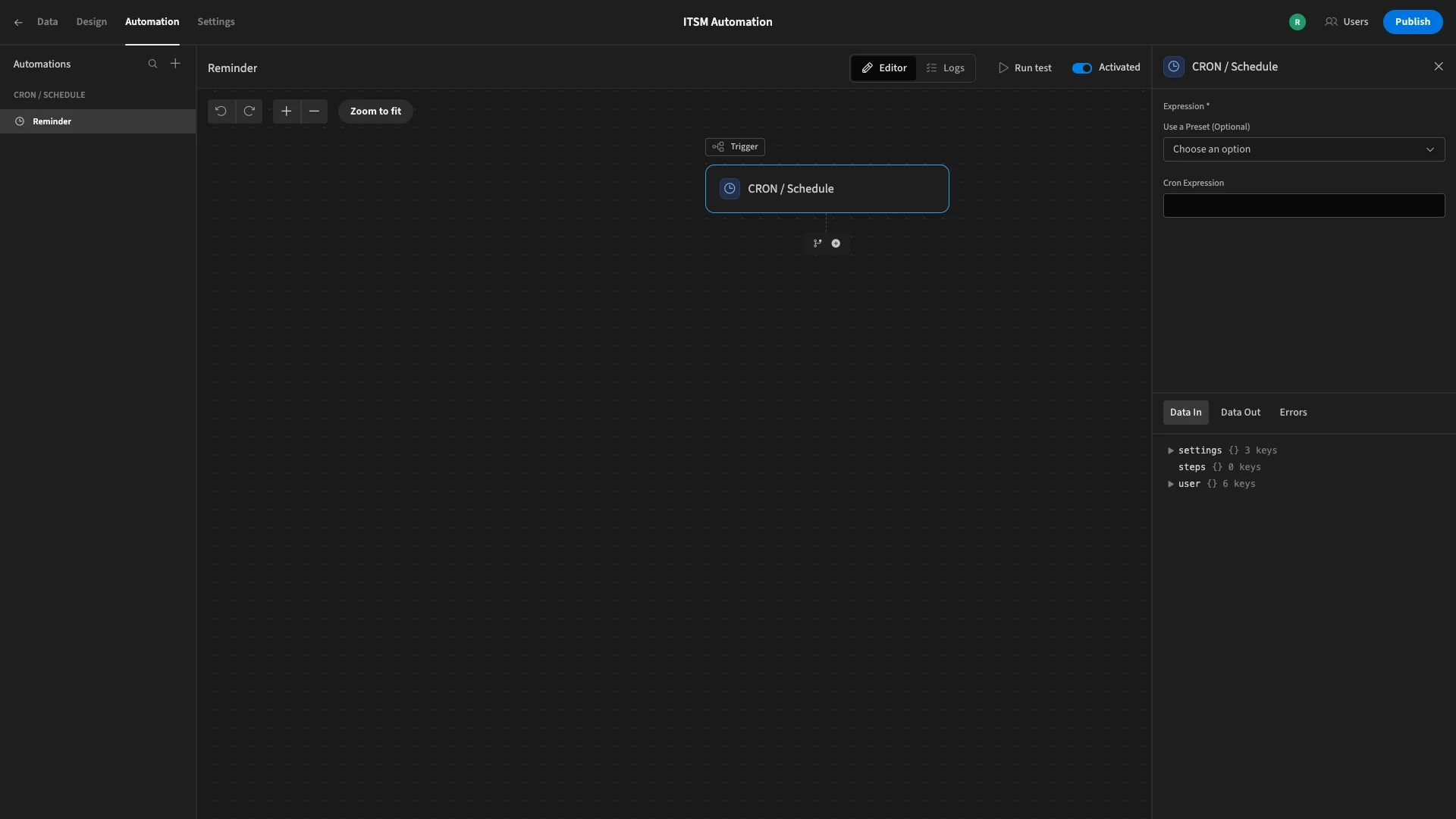
We have the option of using a preset, but we want to write a custom CRON expression, so that our automation will execute every Monday at 9 am.
To do this, we’ll use the expression 0 9 * * 1.
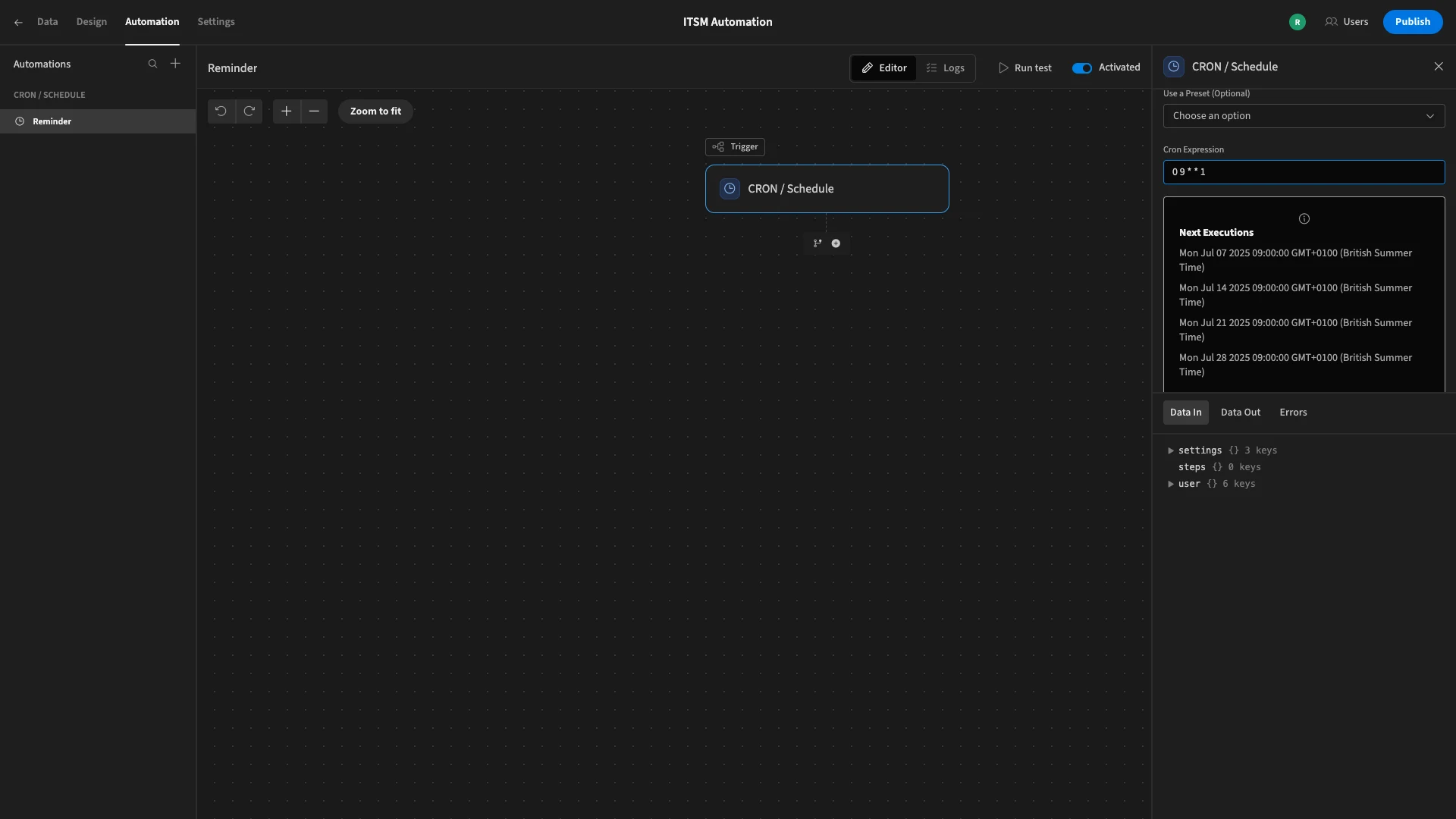
Note that Budibase evaluates our expression, showing us the next execution times, so we can confirm this will work.
Next, we’ll hit the plus icon to add a follow-on action. This opens a side panel where we can see all of Budibase’s available automation actions.
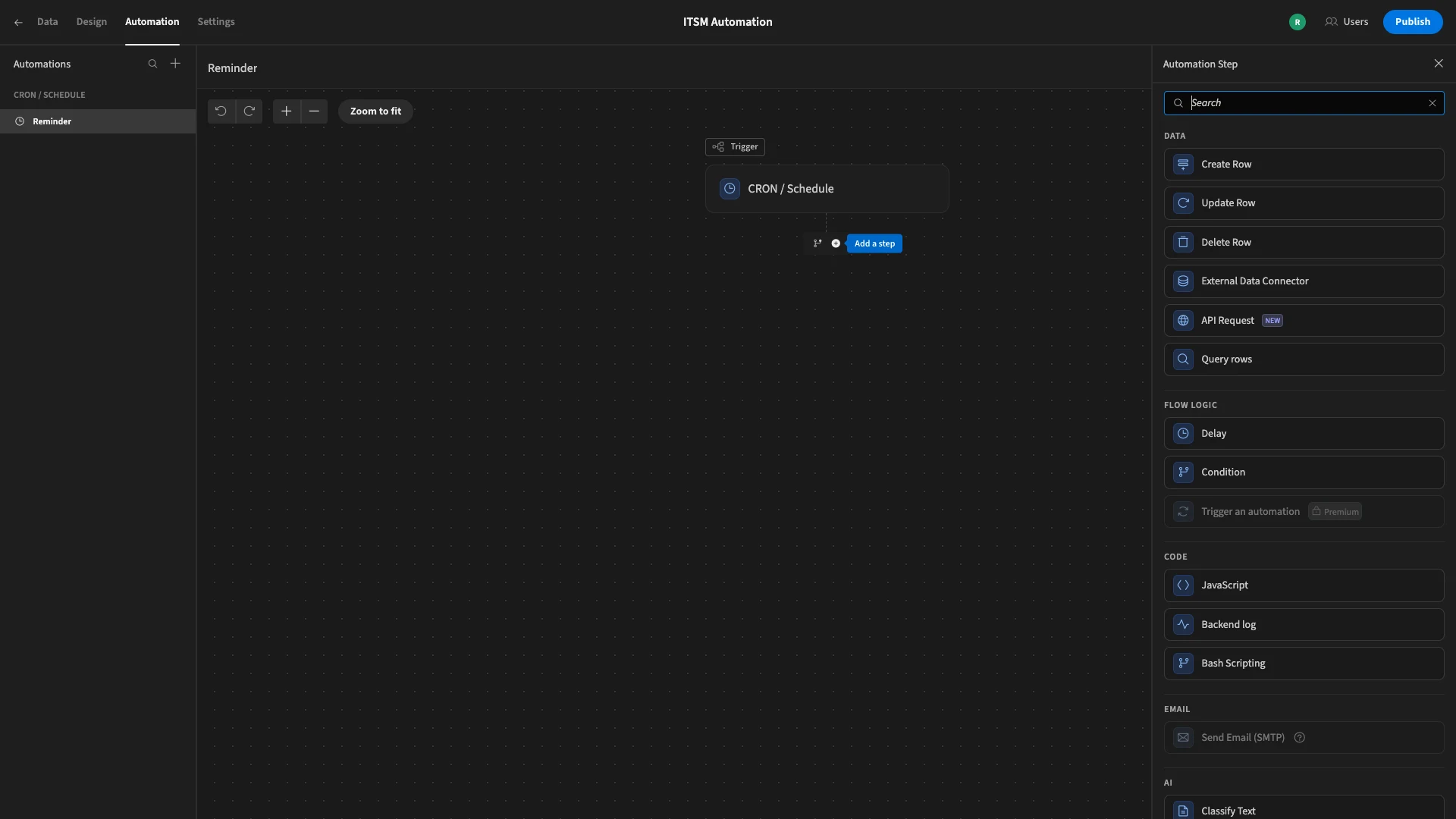
We’re adding a Query Rows step and choosing Tickets as our table.
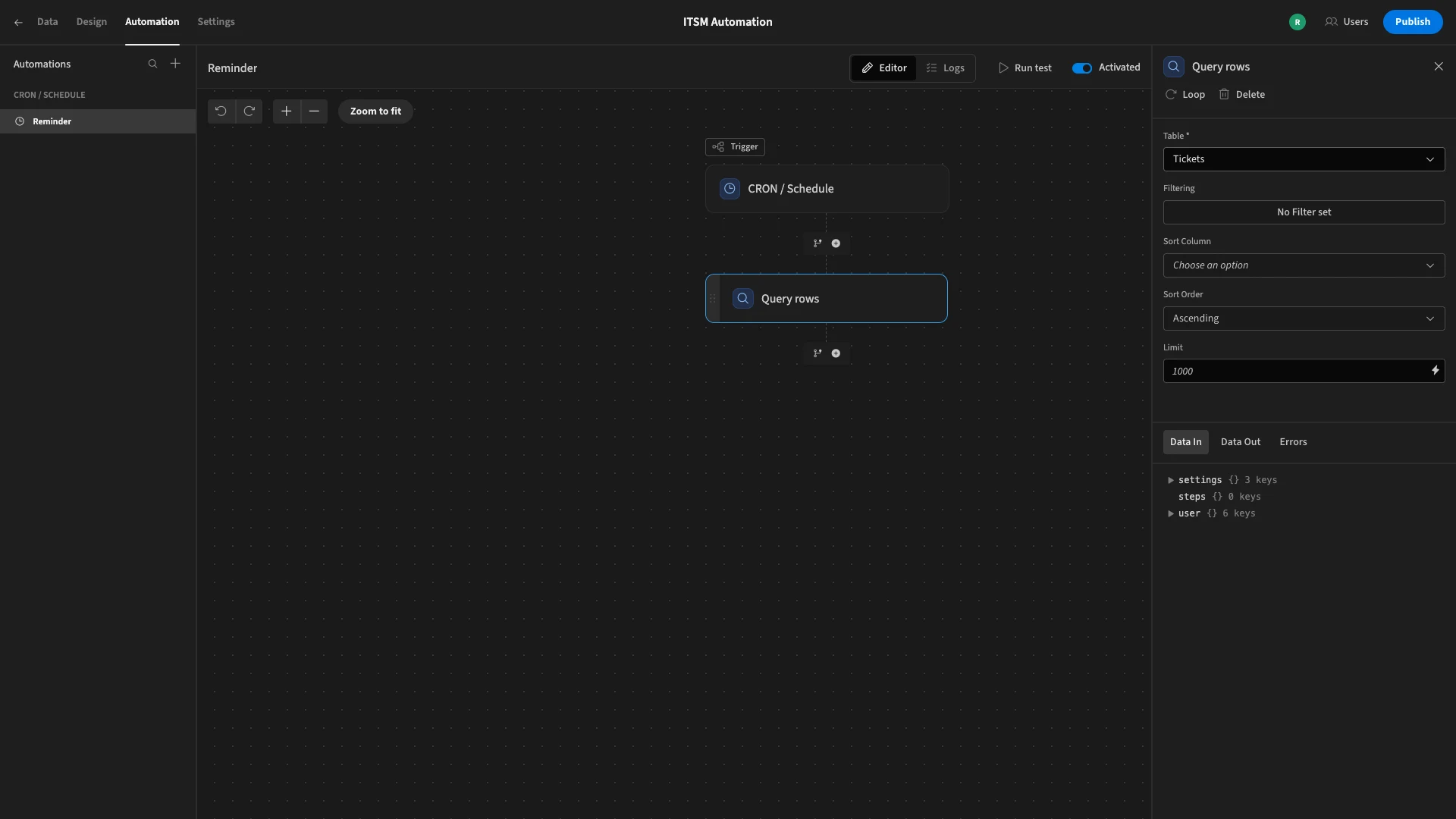
At present, this will return all rows in our database table. We only want the rows that were added in the last week and have their Status set to Open.
To do this, we’ll add a filter.
For the Status expression, we can simply select Open from the dropdown of available options.
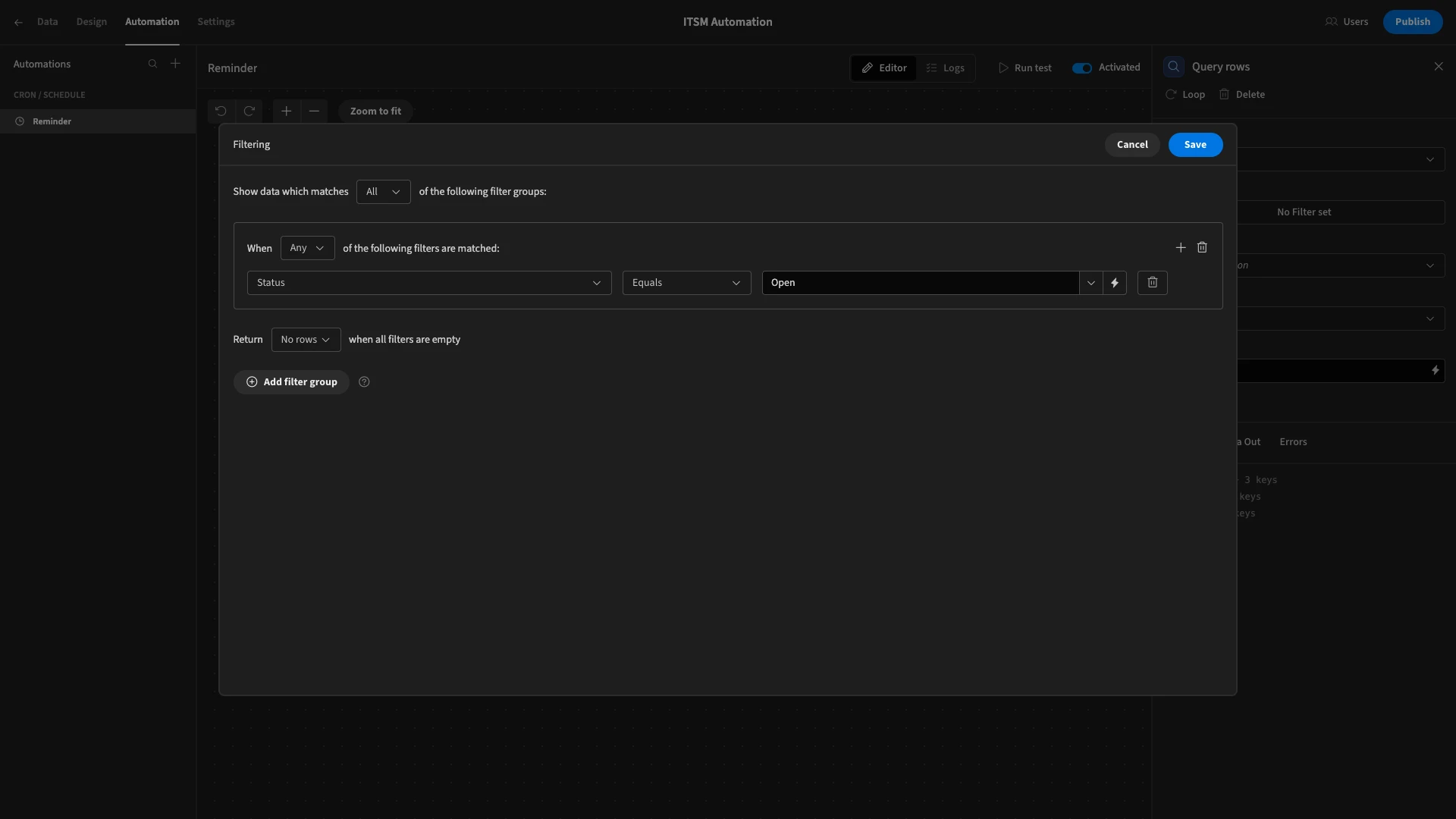
For Submission Date, we’ll create a More than or equal to expression.
We’ll then hit the lightning bolt icon to open the bindings menu, selecting the JavaScript editor.
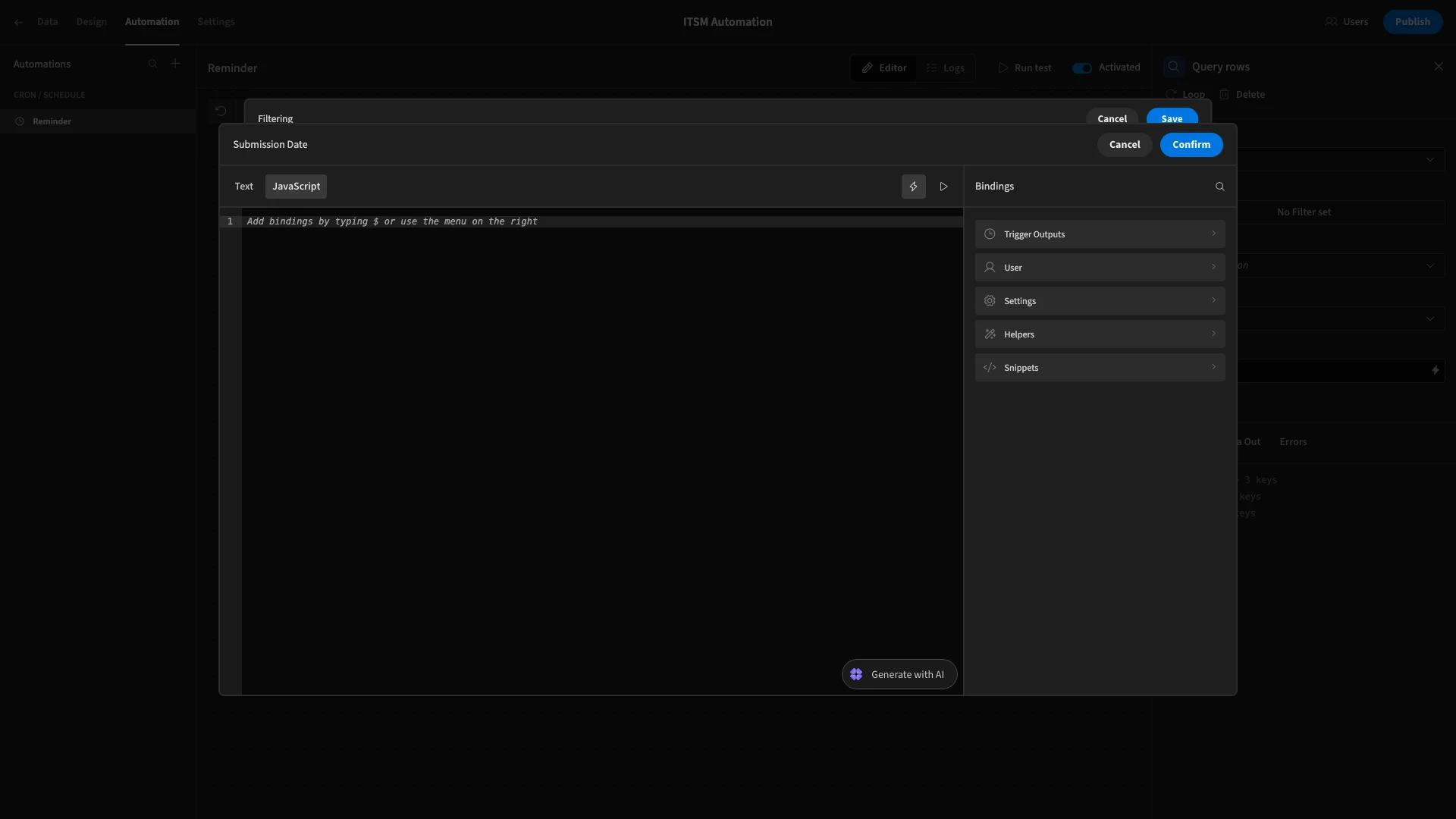
Since our automation rule will run every Monday at 9 am, we can simply create an expression that will return all rows that were created in the past seven days.
We’ll use the following JavaScript.
1const now = new Date();
2
3const sevenDaysAgo = new Date(now.setDate(now.getDate() - 7));
4
5return sevenDaysAgo;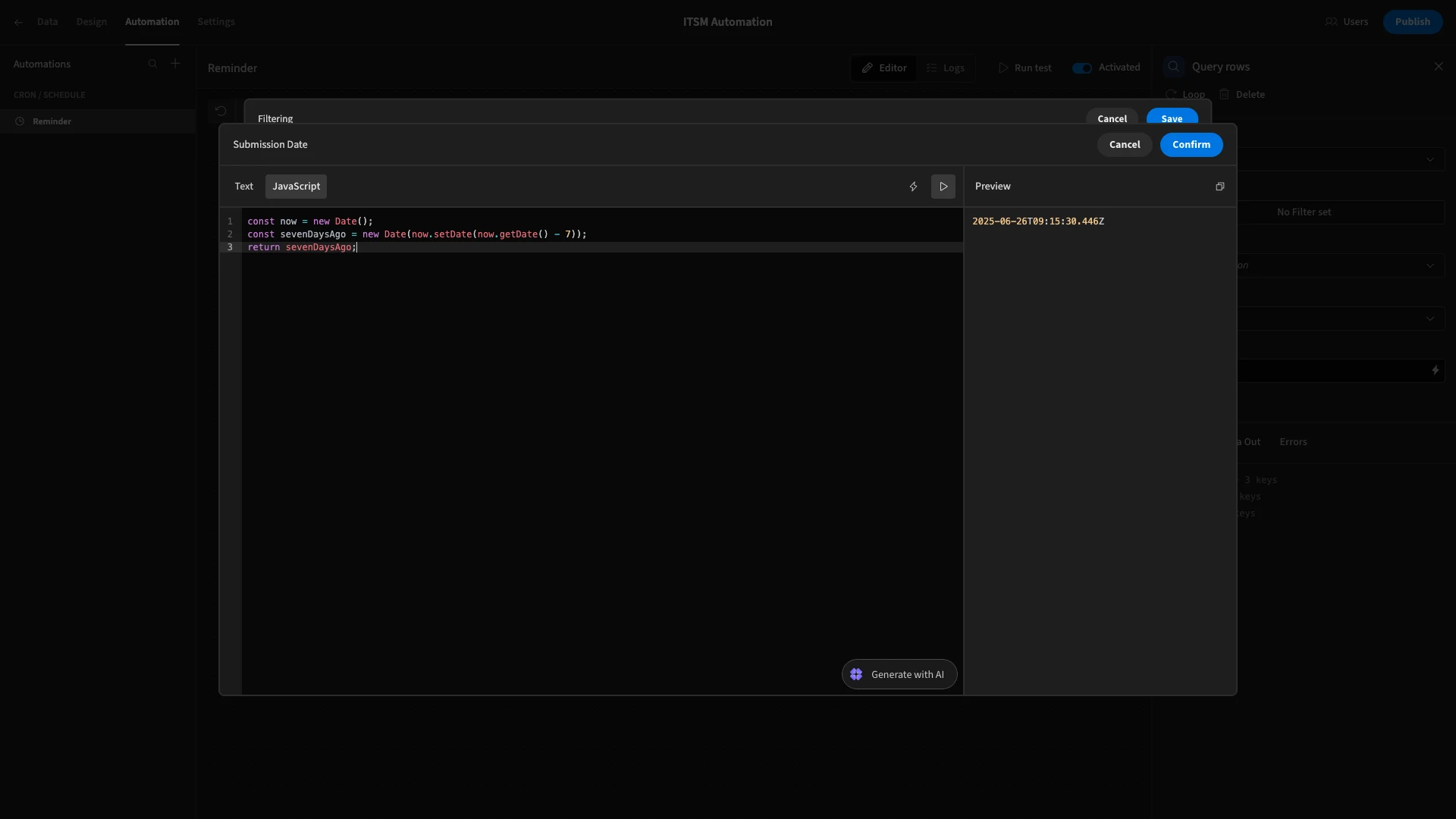
When we run a test, we can see that our ITSM automation has correctly returned two open tickets from the past seven days.
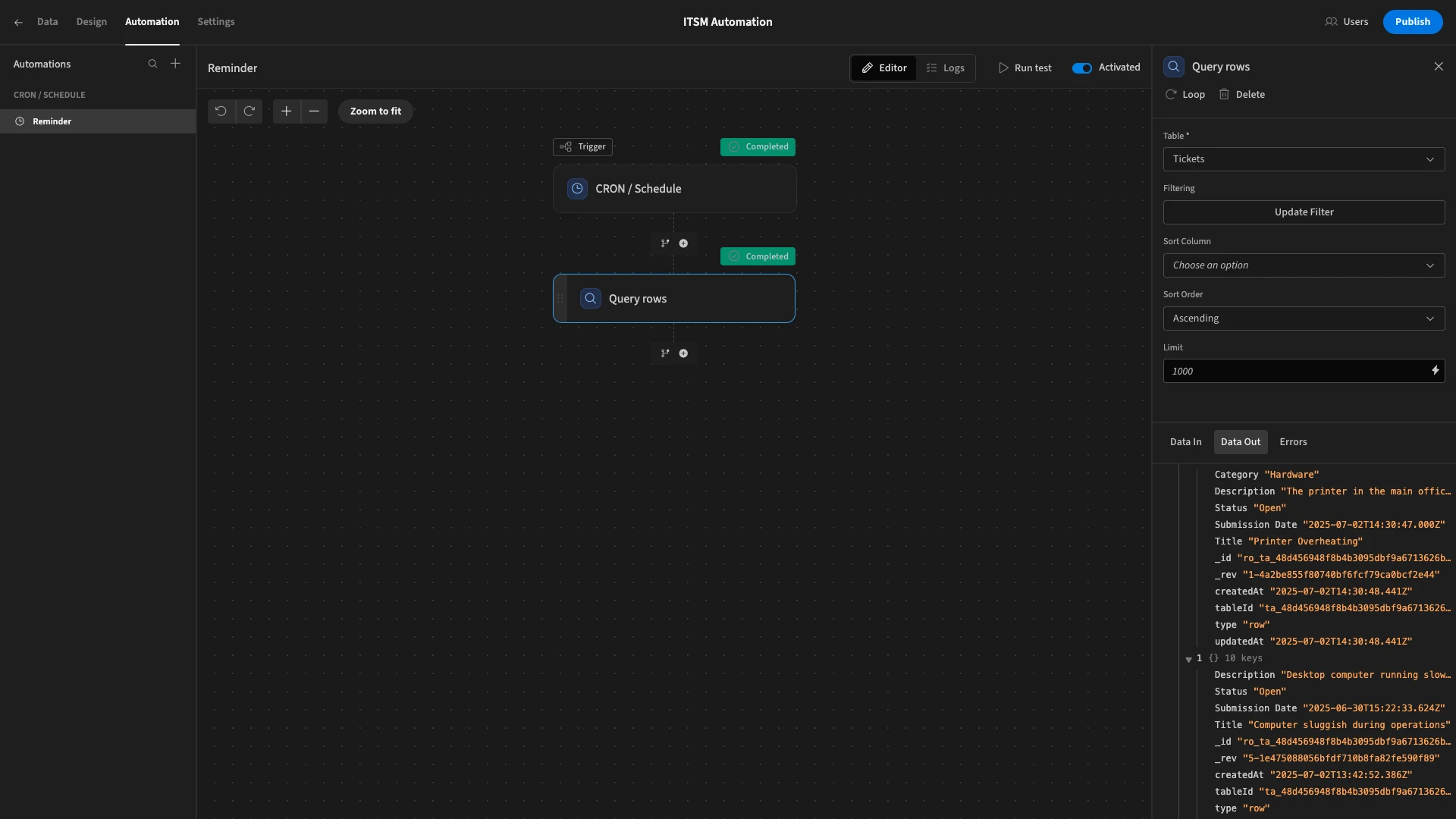
We could then use this information to populate an email to our service desk, reminding them that they need to pick up these tickets this week.
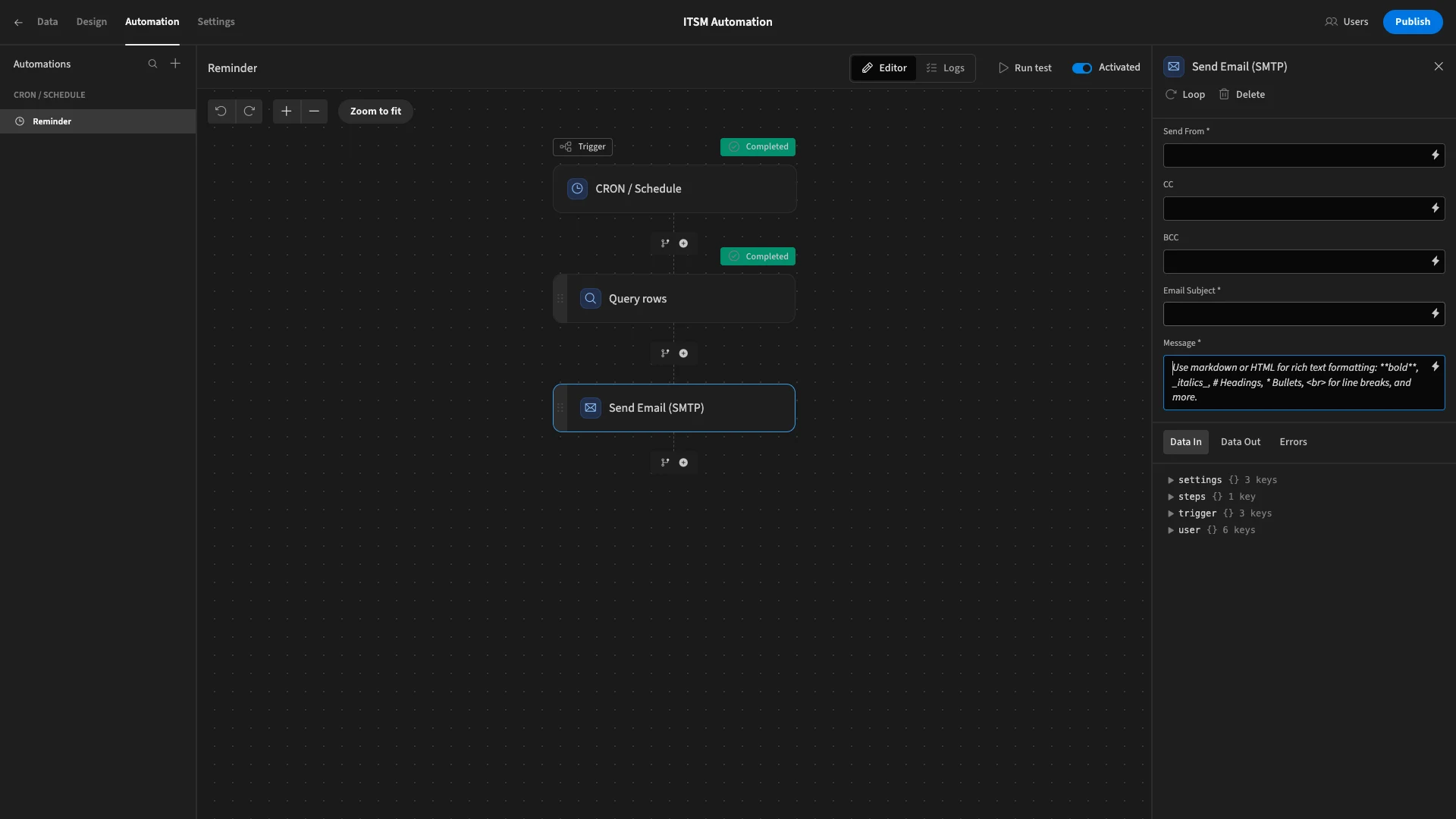
Requests and approvals
Many ITSM workflows take the form of request and approval sequences. These are some of the most ubiquitous types of business rules, helping to determine whether an end user meets the criteria to access a given service.
For our example, we’re going to look at a simple asset request workflow. Within this, we’ll automatically approve rental requests for assets in certain low-risk categories.
We’re starting with a lightweight device rental form, where users can input their name, the date of their request, and the device they need. The dropdown picker for devices will link the request to the relevant row in our IT Assets table.
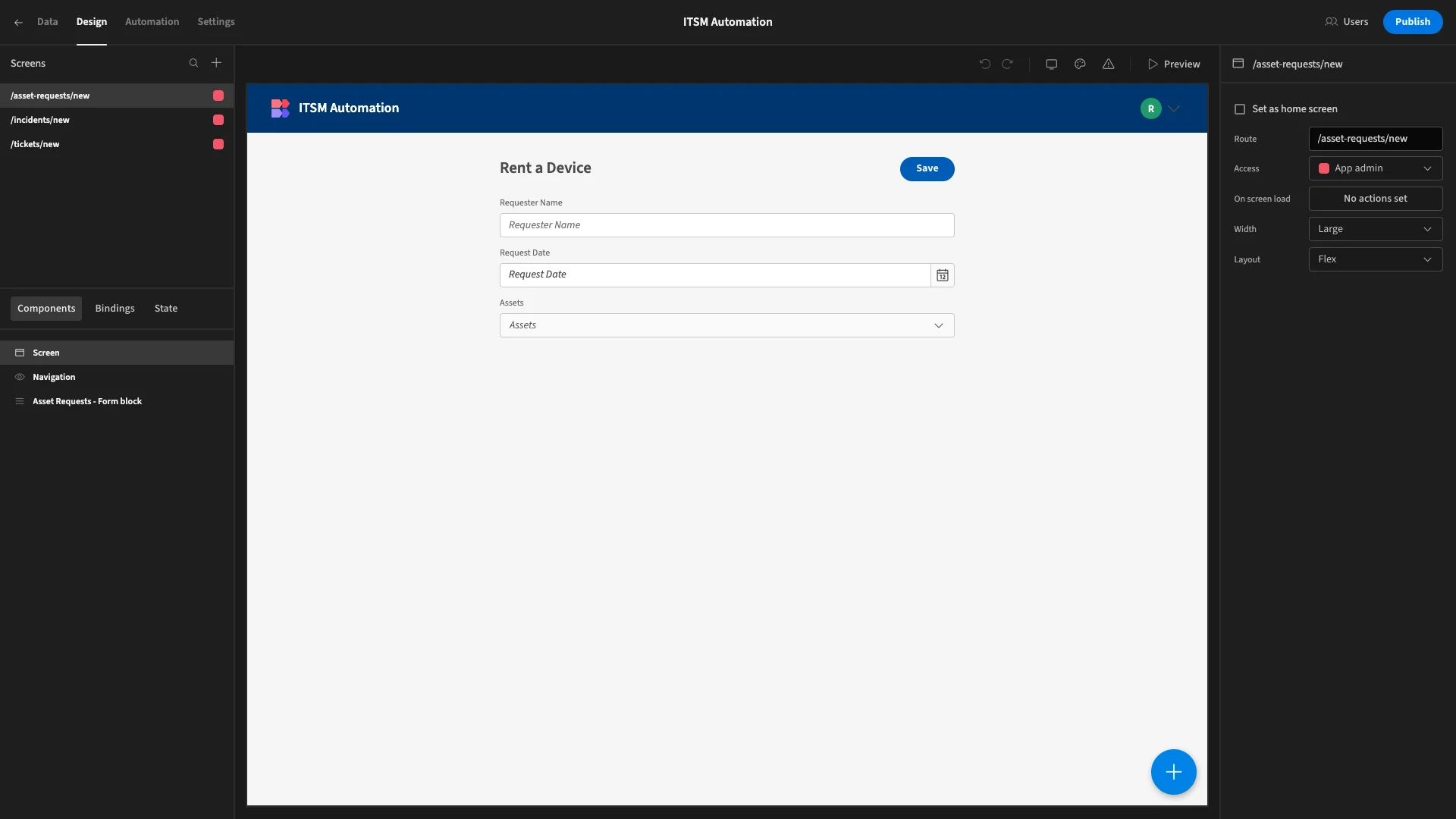
We want to automatically approve any requests for accessories that are currently set to available.
We’ve created a new automation rule with a Row Created trigger, pointed at our Asset Requests table.
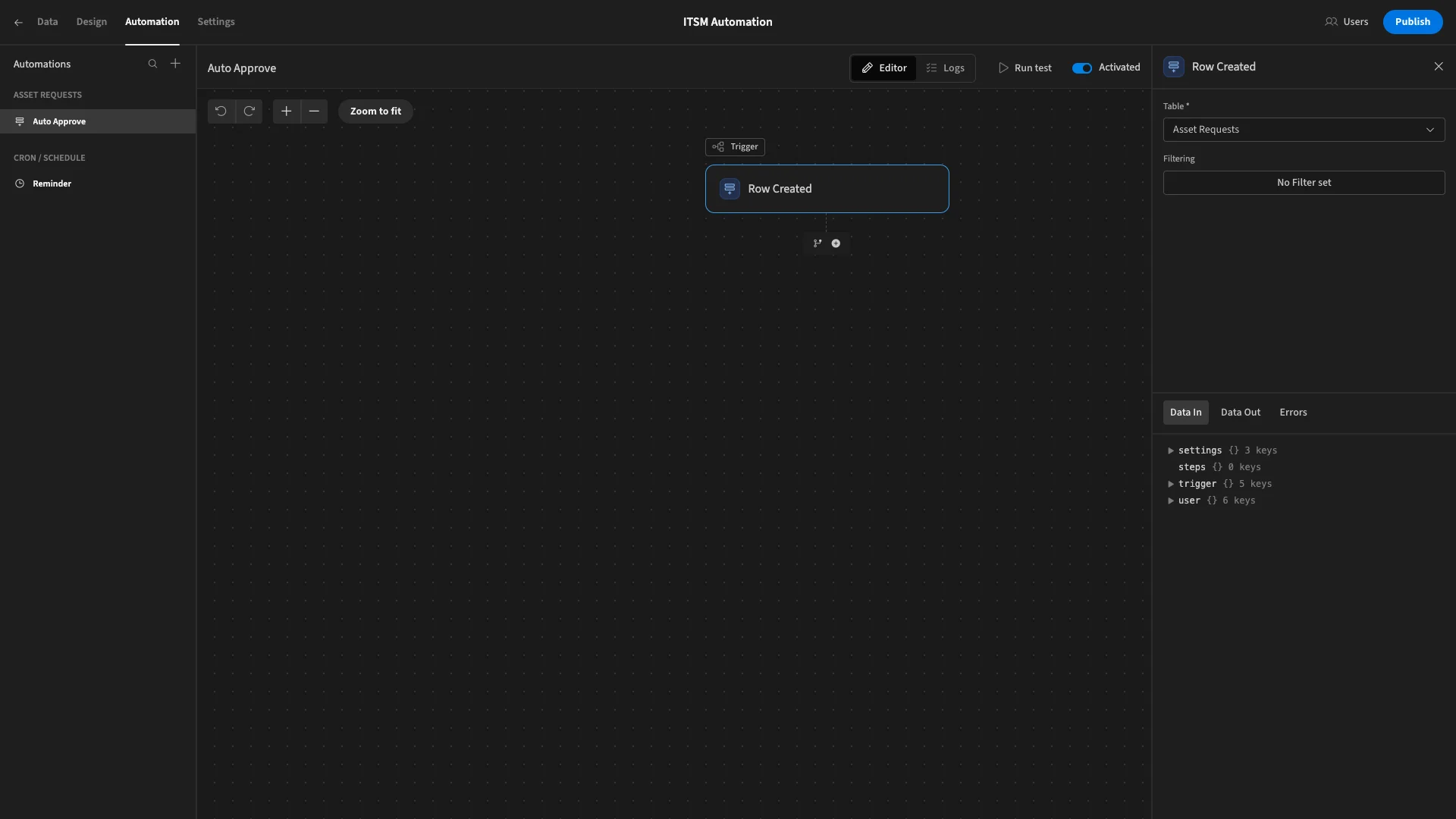
Before we can process the request, we need to retrieve the relevant data from the associated IT Assets row.
To do this, we’ll use another Query Rows step, pointing it at our IT Assets table.
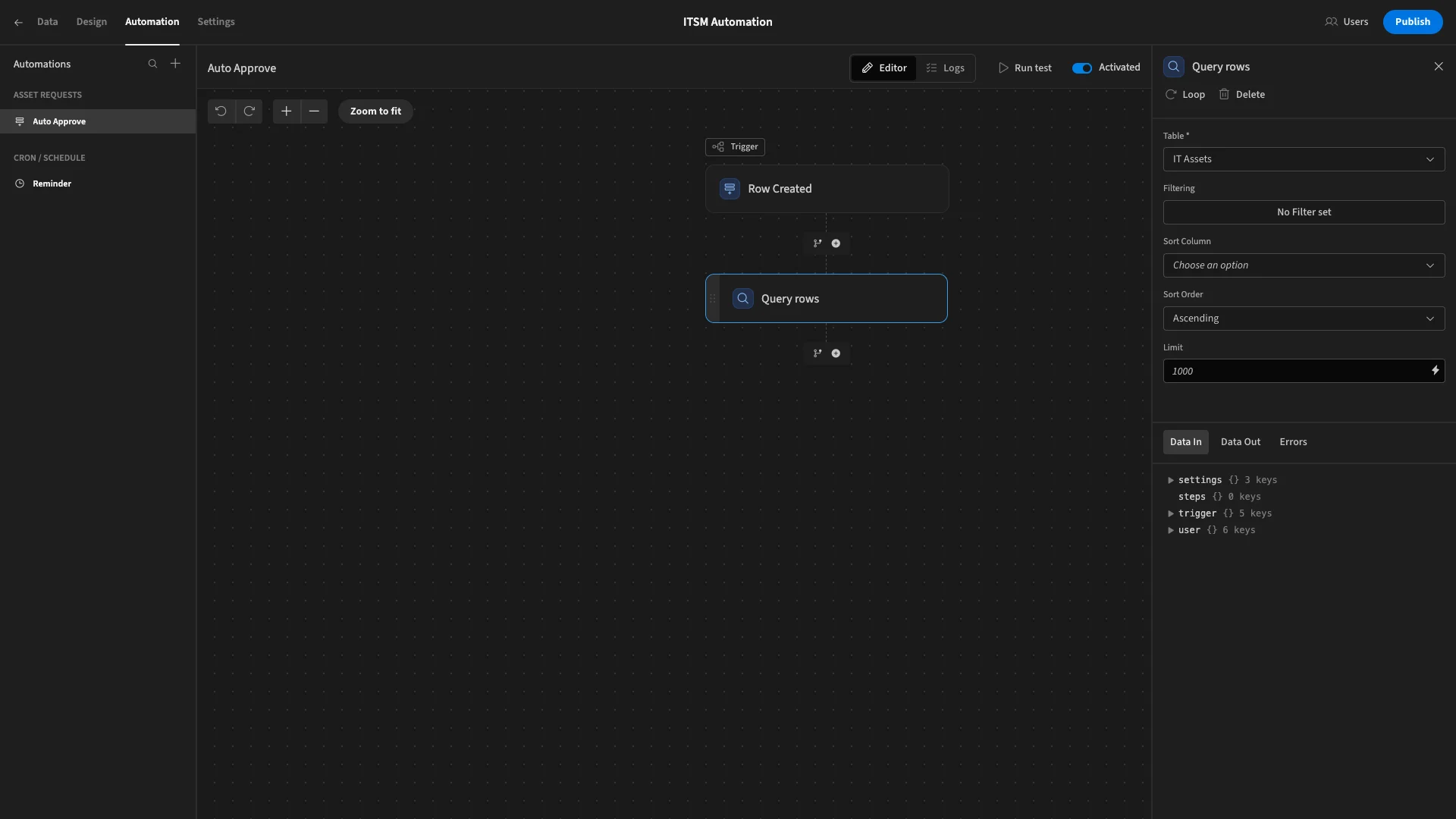
This time, we need to add a filter so that only the row that our original request applies to is returned, using {{ trigger.row.Assets.0._id }}.
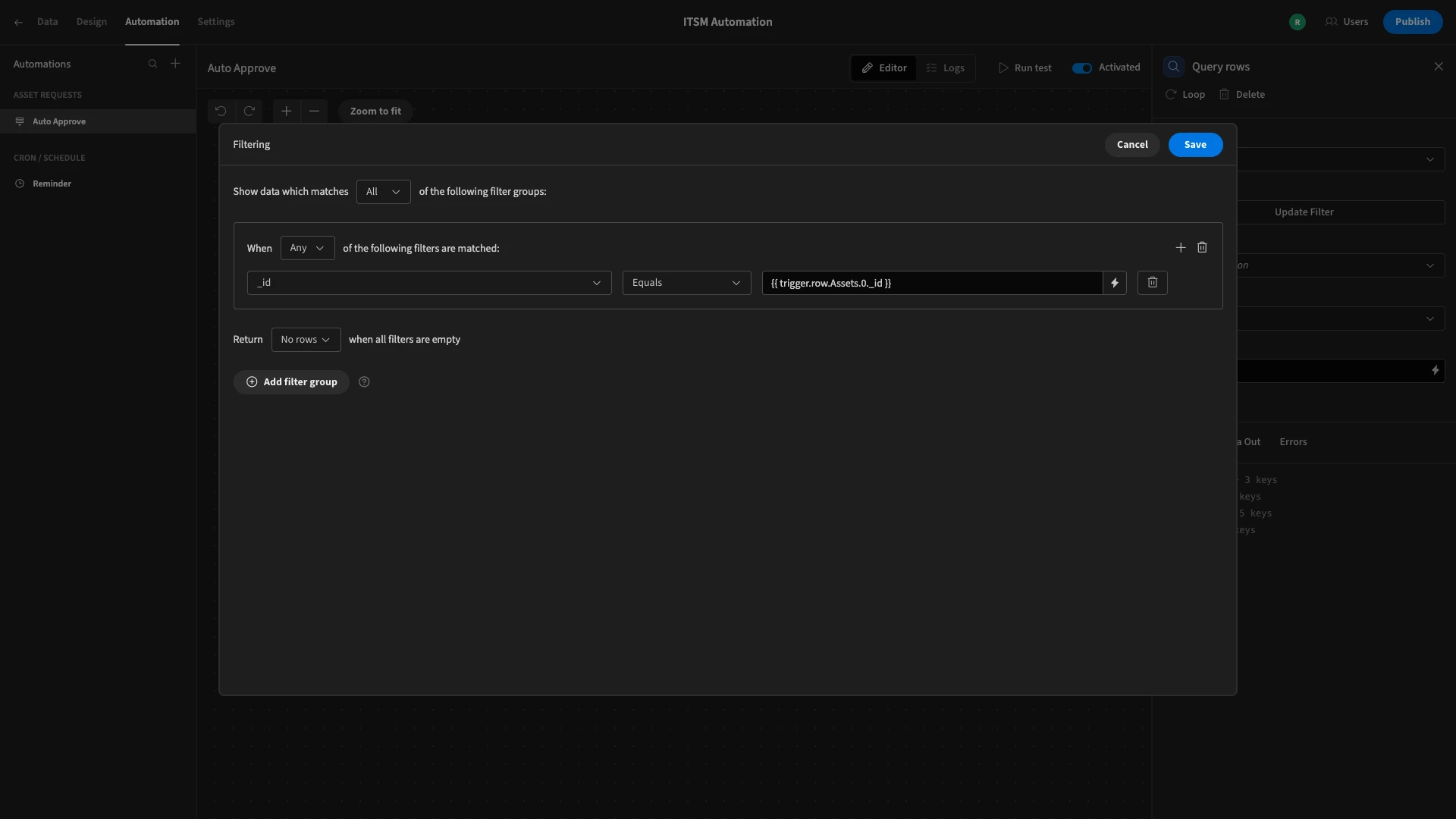
We only want to continue with our automation rule if the requested device is an accessory and it’s currently available.
We’ll achieve this by adding Condition steps. This is a logic step that accepts a reference value, a condition, and a comparison value. If the condition is met, the flow will continue.
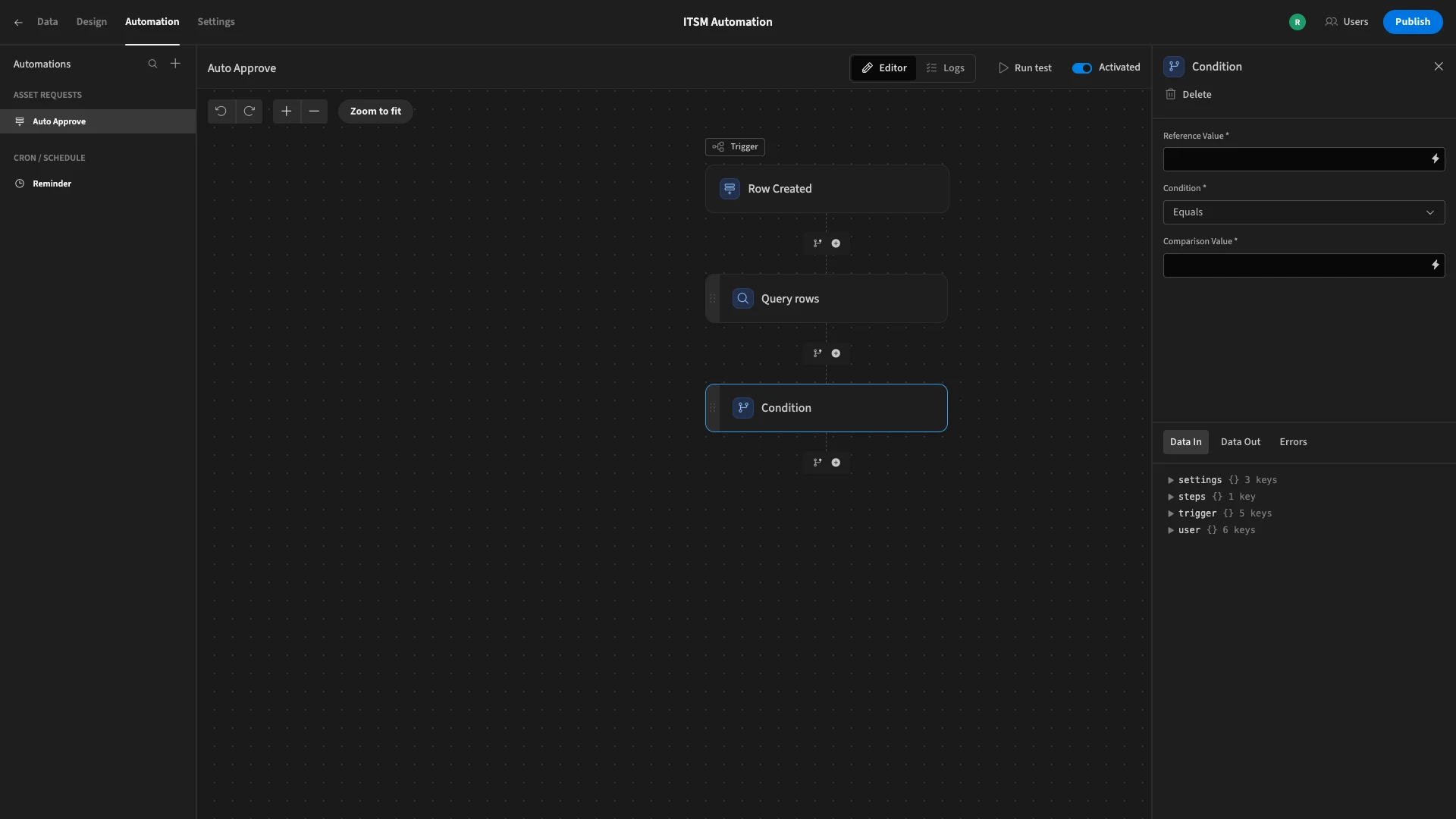
We’re going to use the outputs from the previous step to handle this. For our first condition, our reference value is {{ steps.Query rows.rows.0.Category }} and our comparison value is Accessories.
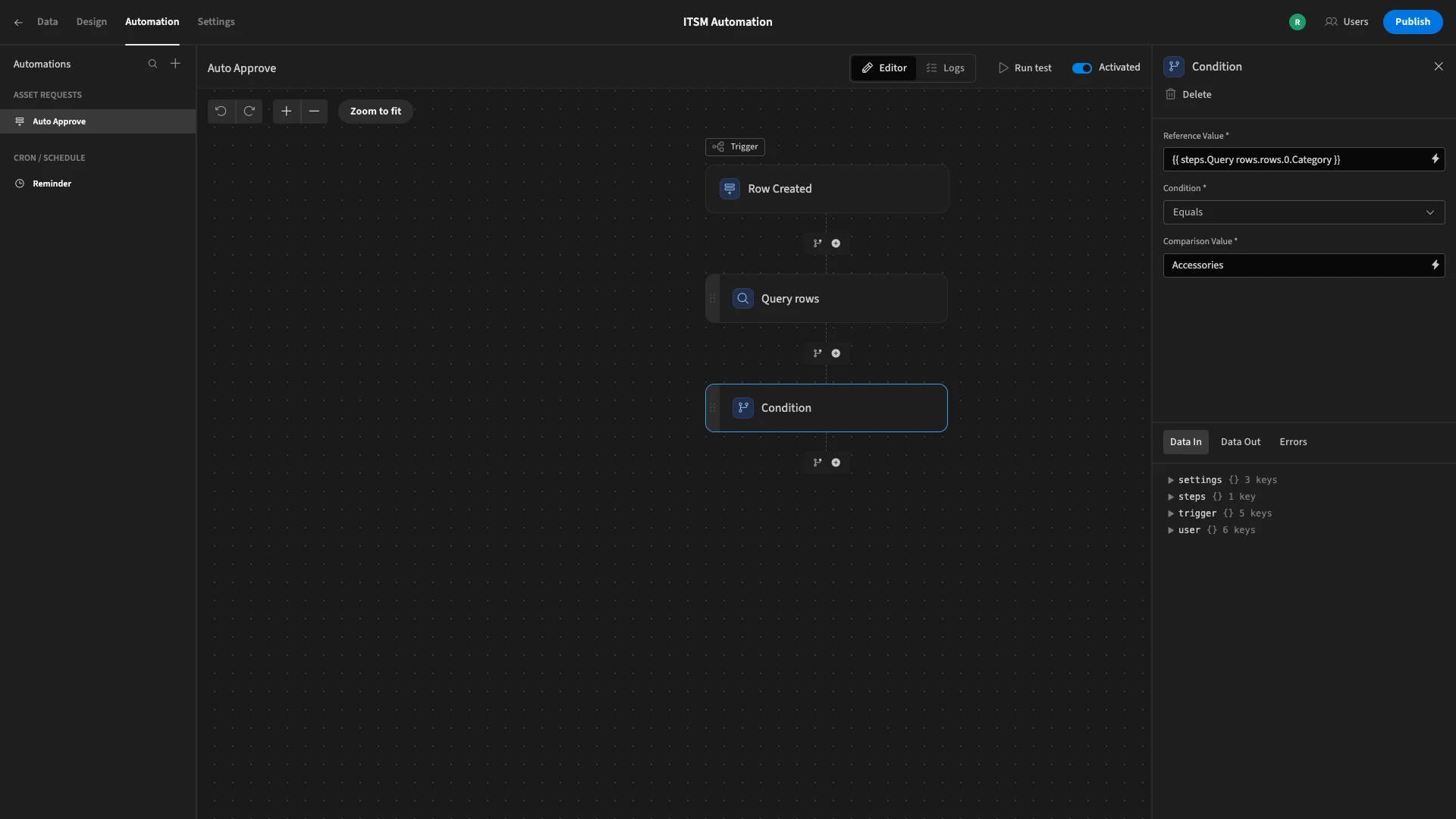
We’ll add a second Condition, setting the reference value to {{ steps.Query rows.rows.0.Status }} and the comparison value to Available.
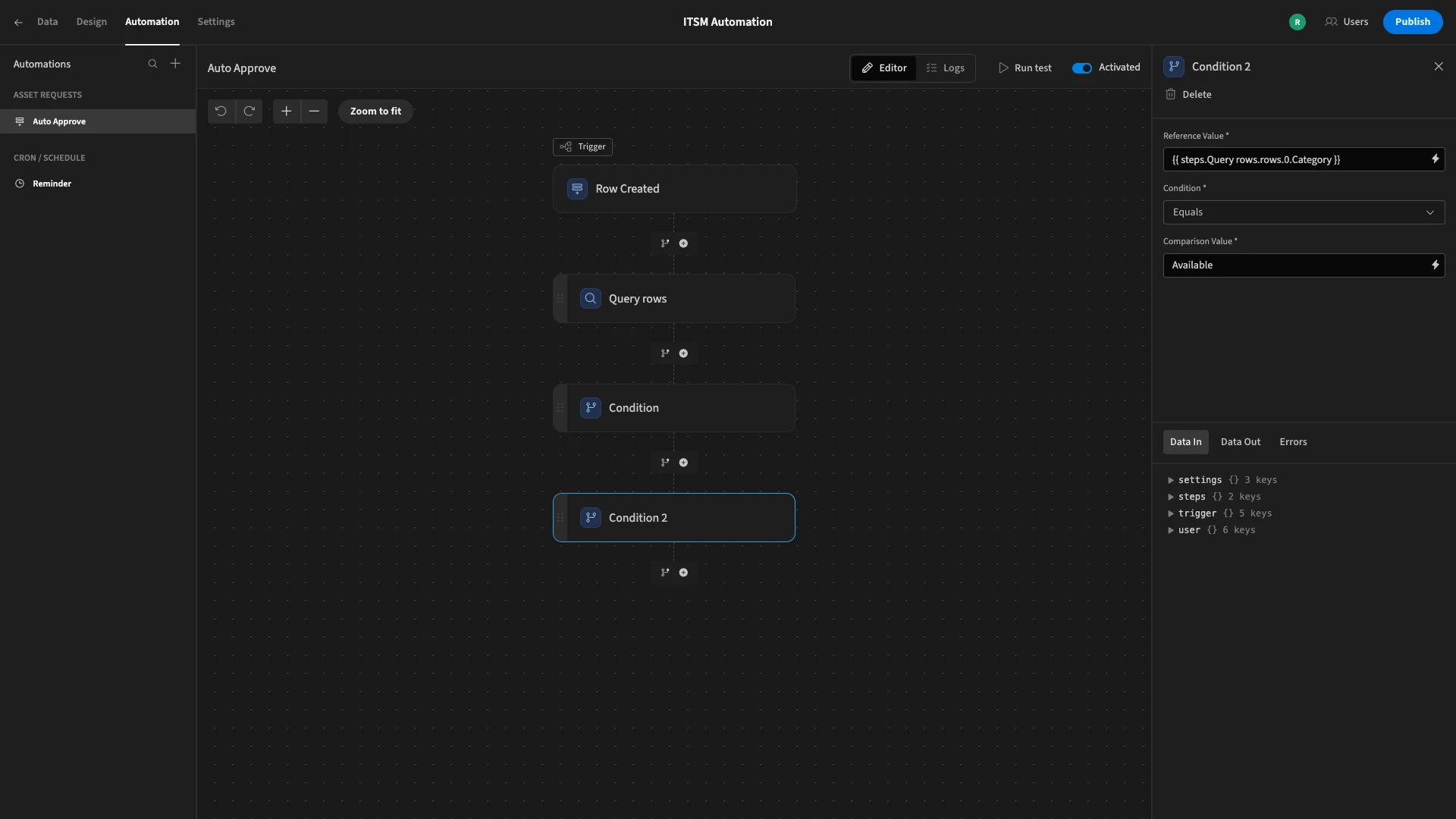
Next, we need to update the Status attributes of the relevant rows in both tables to approve the request.
We’ll start by adding an Update Row action, pointing it at our Asset Requests table.
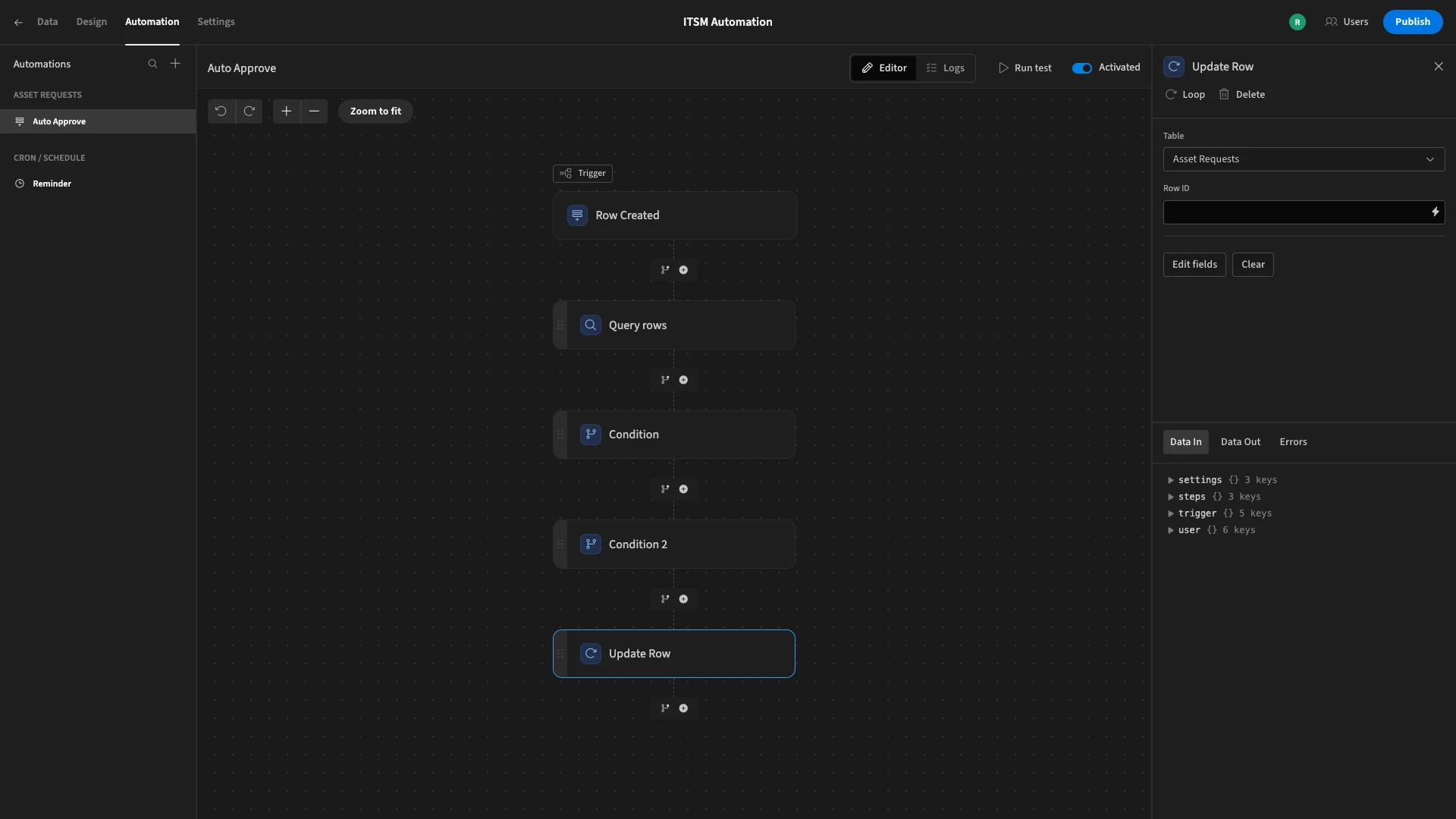
There’s a Row ID field here, where we need to specify which specific row in the table we want to update. We’re going to set ours to the original row that triggered the request, using {{ trigger.id }}.
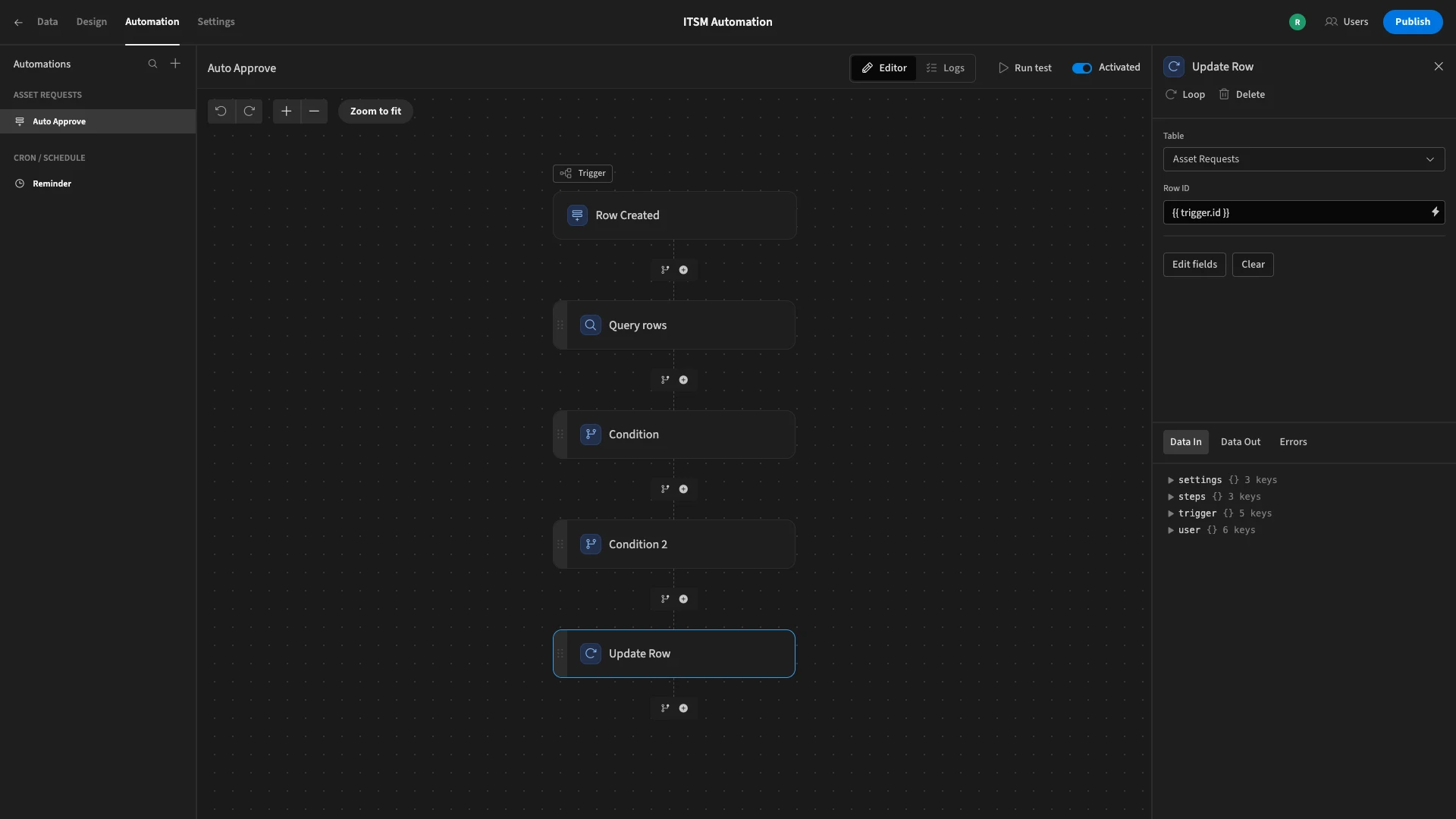
We’ll then add our Status field and set this to Approved.
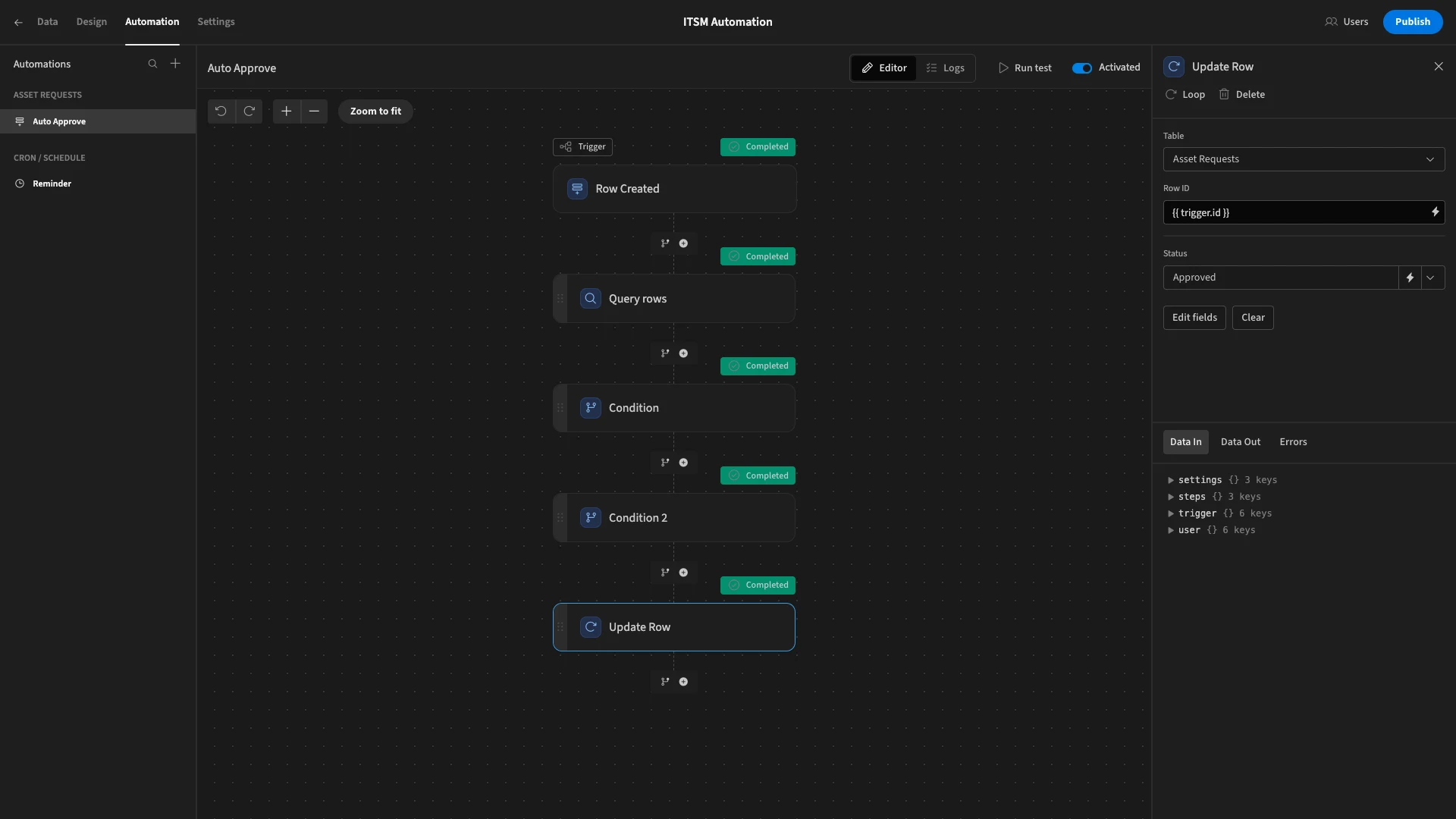
We’ll then repeat this process for our IT Assets table, using the _id output from our Query Rows step to set the Status to Reserved.
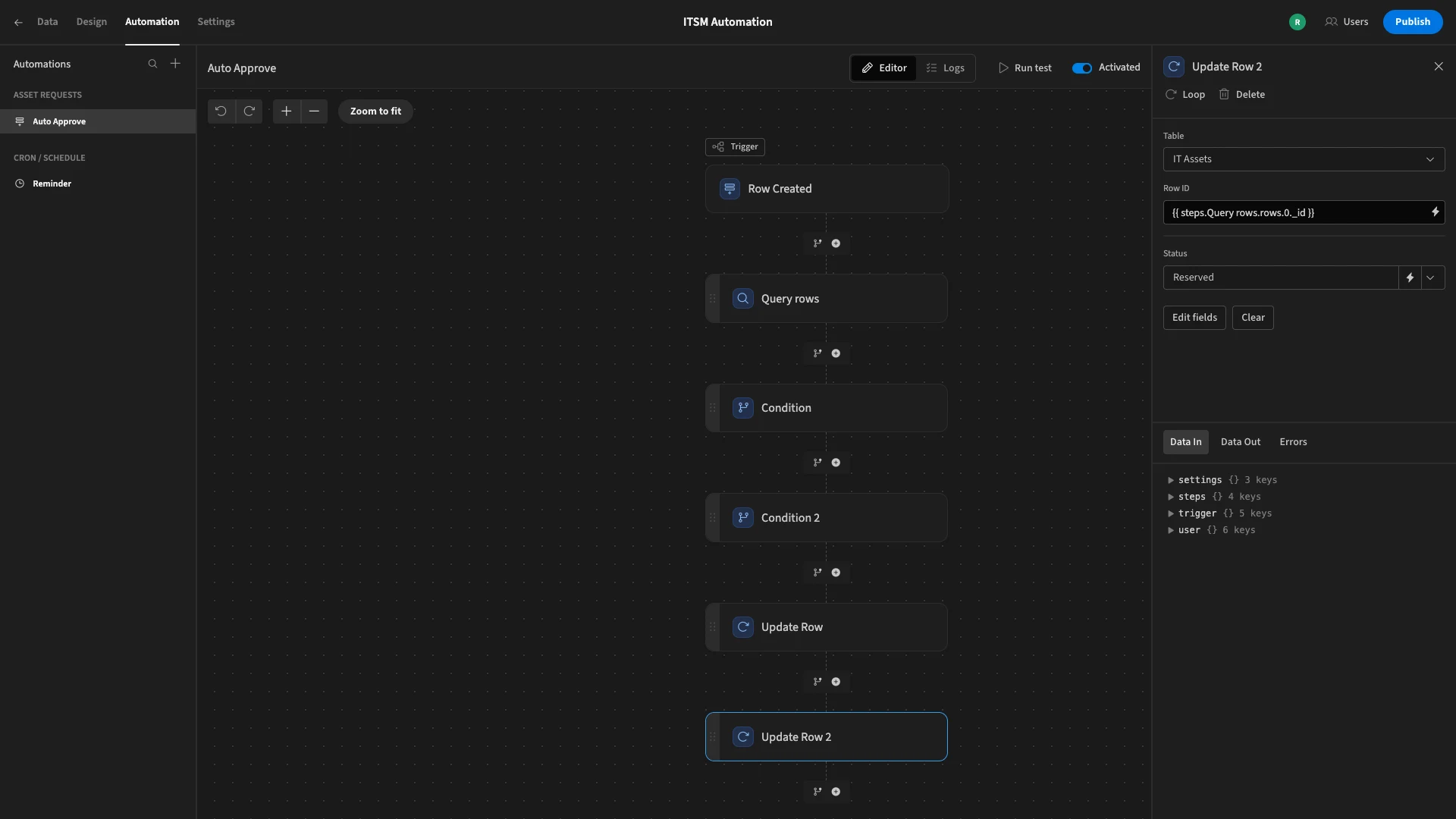
When we run a test, we can see that our ITSM automation flow has executed successfully.
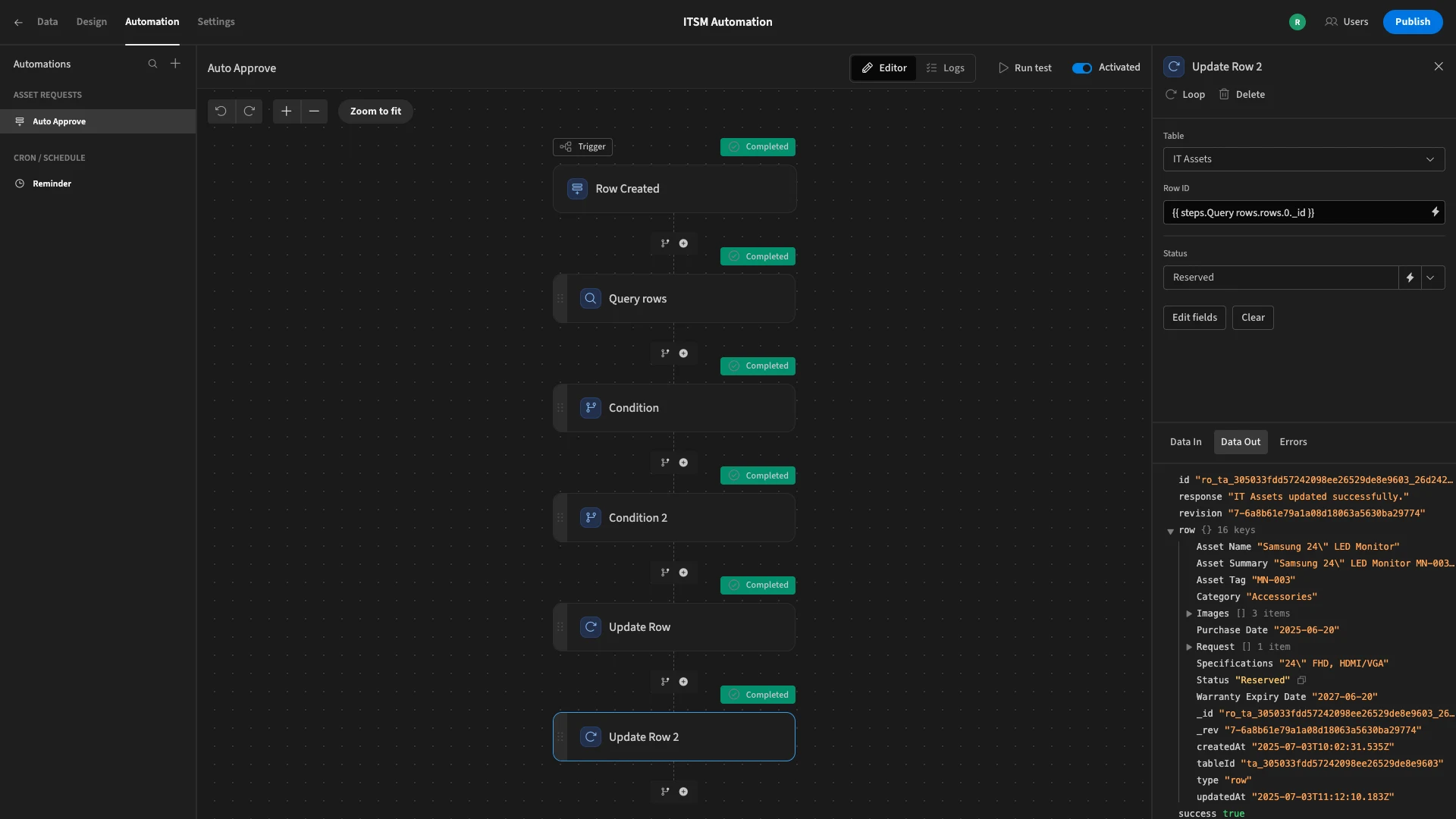
Generating responses
Lastly, modern AI-powered automation can be used to generate responses to tickets and other queries. These can either be sent to end users or used internally as suggestions for how to proceed within the IT team.
To demonstrate this, we’ll return to our Tickets table.
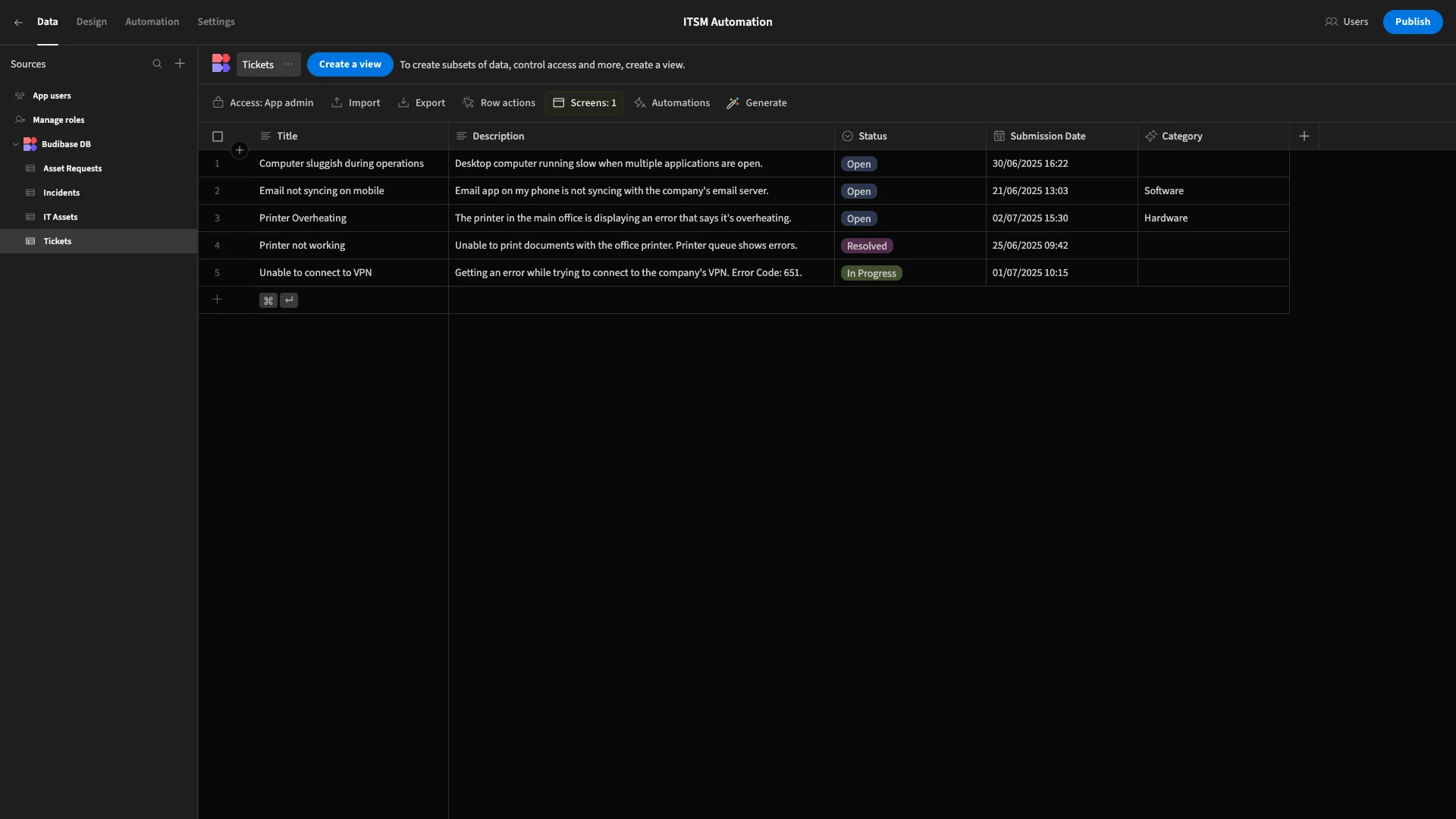
This time, we’ll add an AI column with the Prompt operation, and call it Suggested Response.
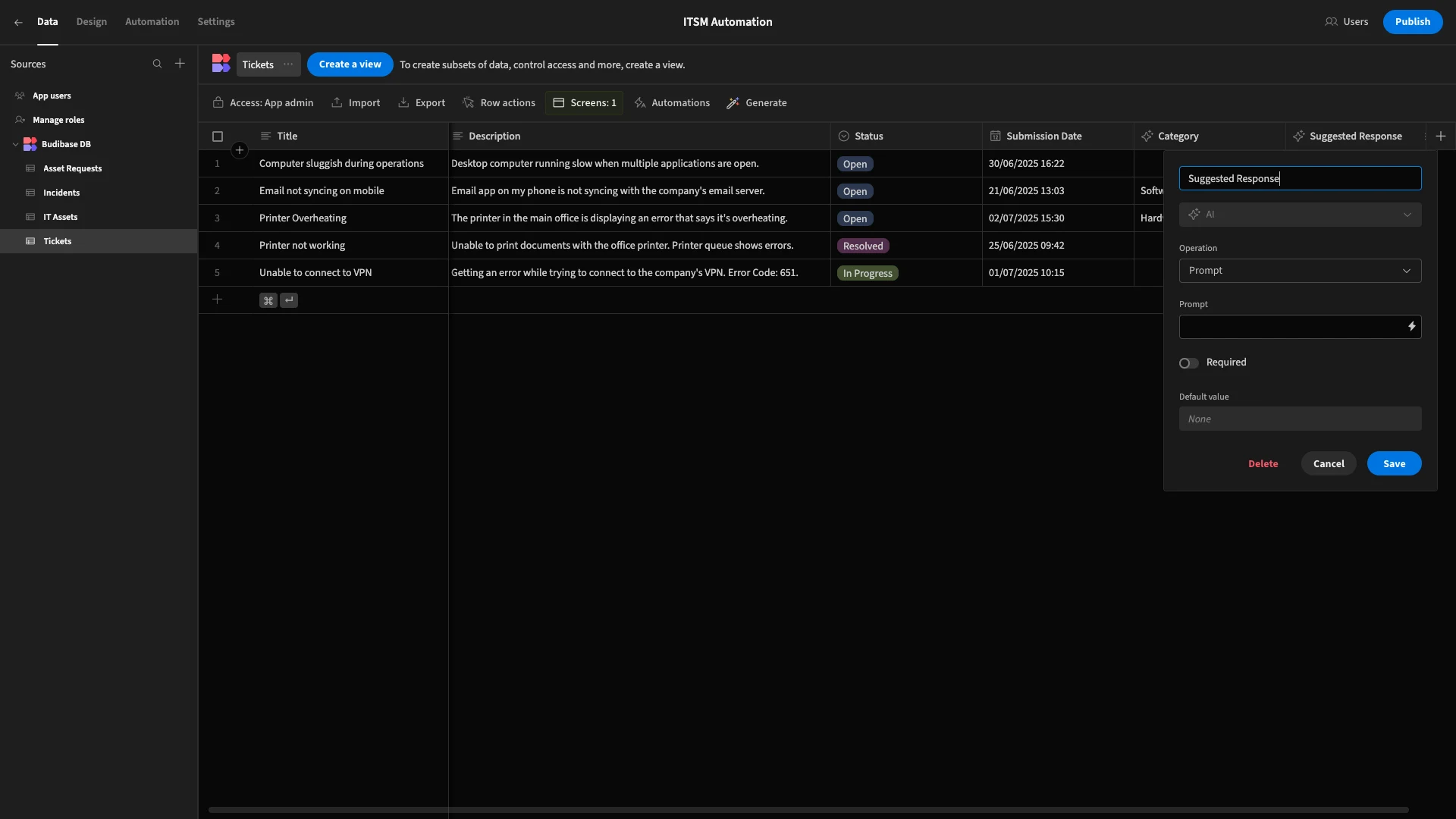
Again, we’ll open up the modal screen to edit our prompt.
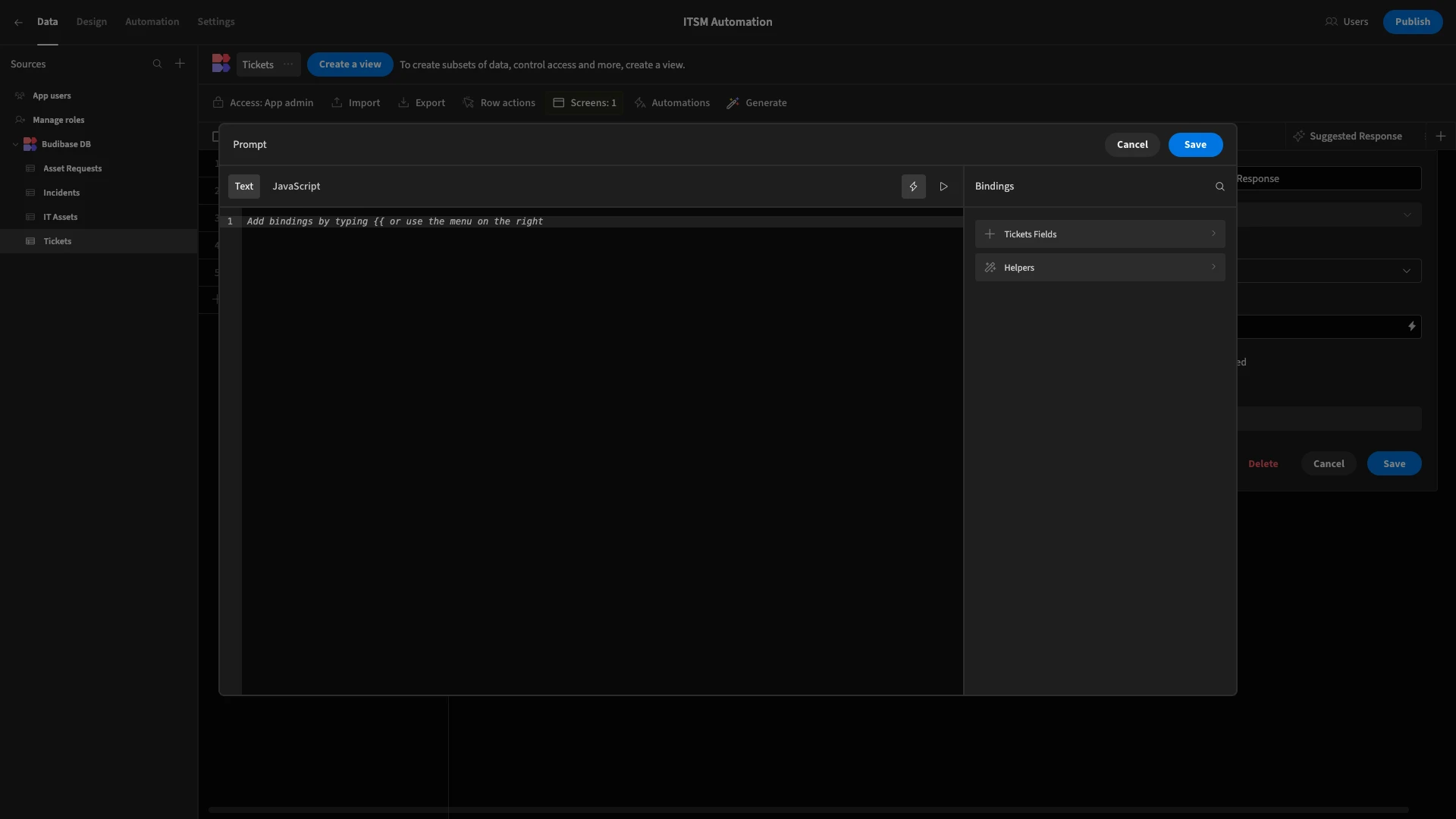
For a real-world solution, we’d likely want to provide more detailed instructions for handling different kinds of tickets or even specific resources that could be used to resolve the issue.
But, for the purposes of demonstrating how this might work, we’re going with a relatively lightweight prompt.
Specifically, we’ll use:
1You are an IT service desk colleague. The following is a ticket submission:
2
3{{ Title }}
4
5{{ Description }}
6
7{{ [Submission Date] }}
8
9Please generate an appropriate response to provide expectations for the user.
10
11Also provide basic troubleshooting steps if relevant.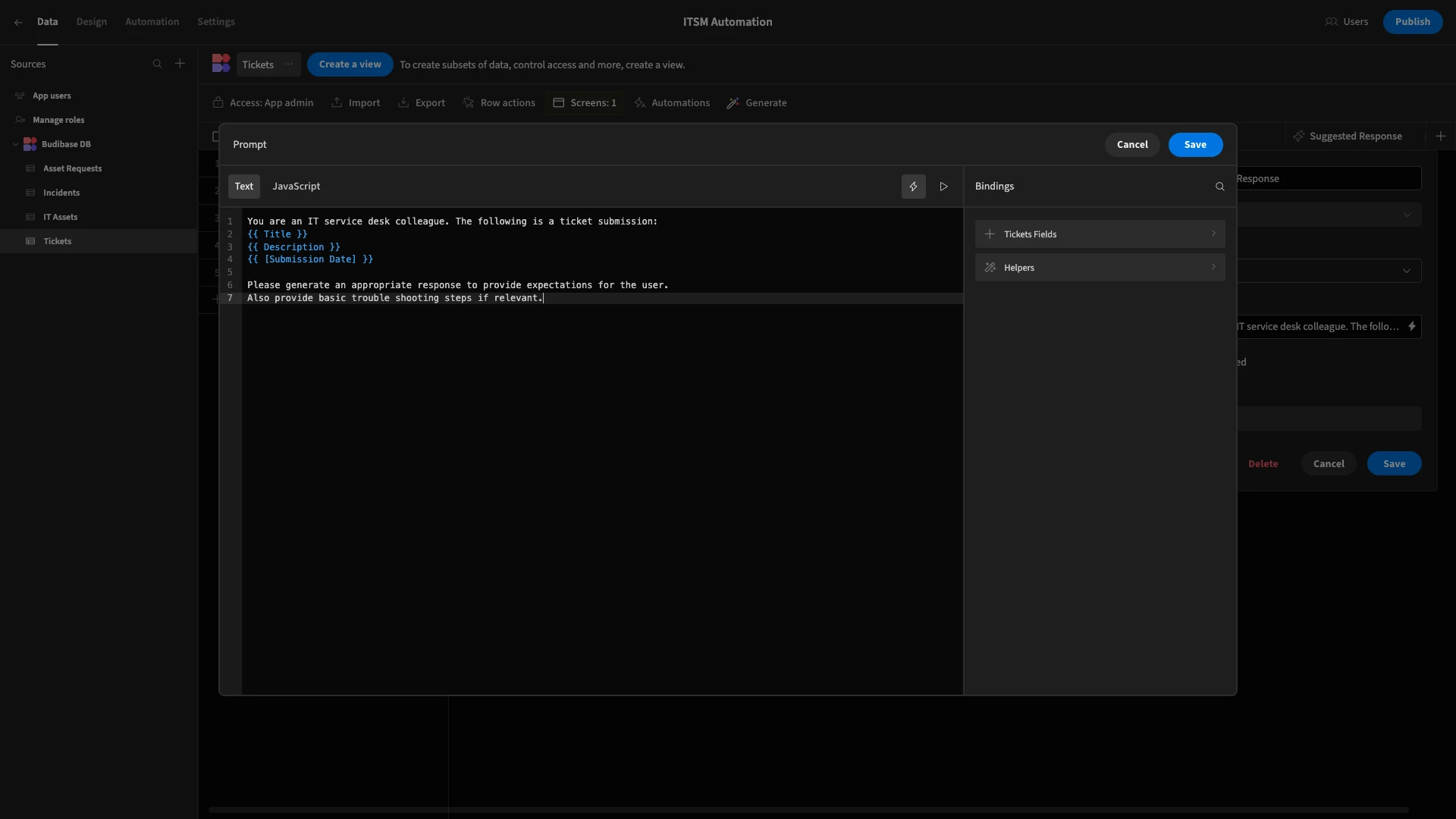
We can test this out by heading back to our original form and submitting another ticket.
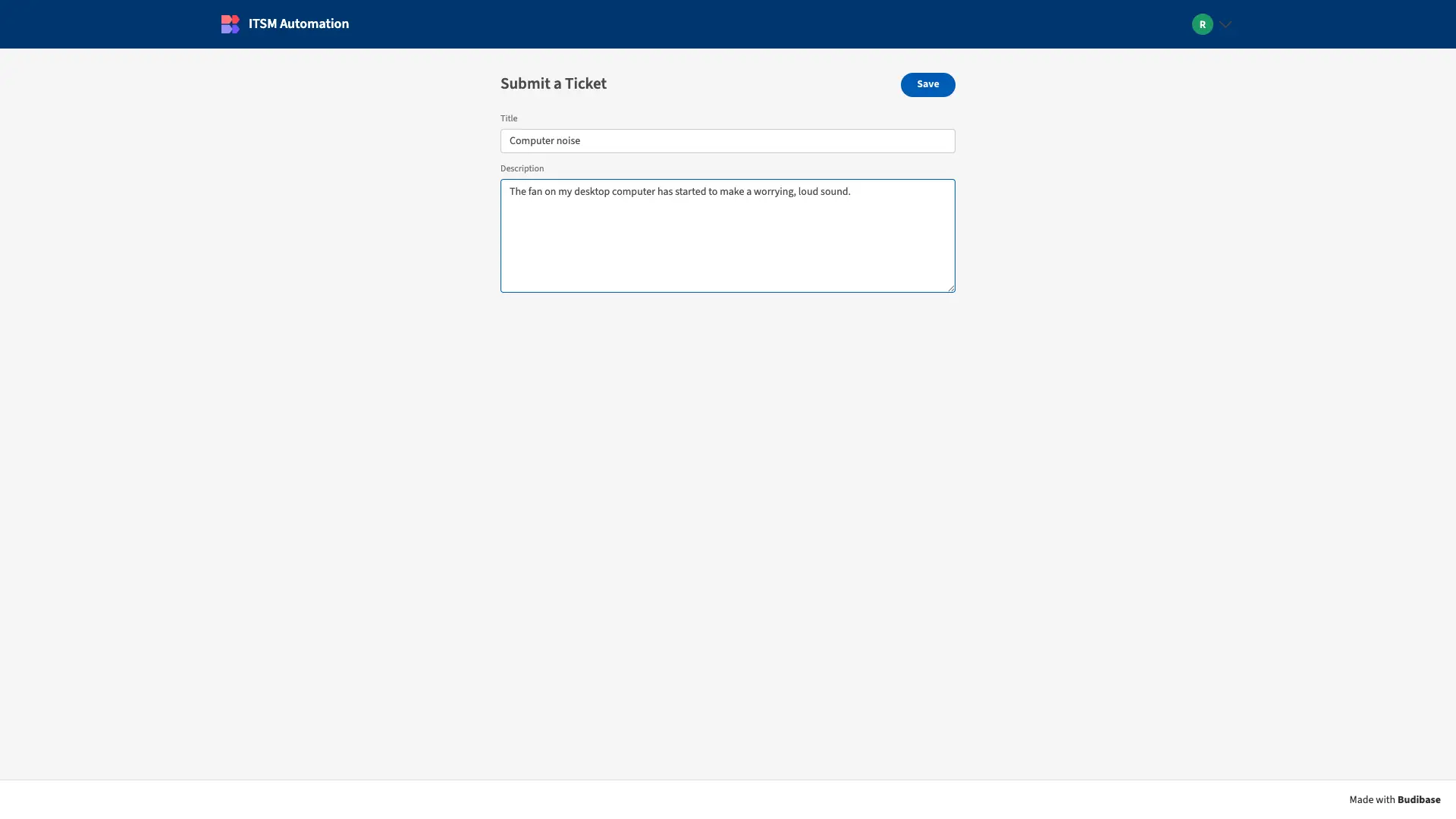
Back in the data section, we can see that our AI column has successfully populated with an appropriate suggested response, which service desk colleagues can use or modify.
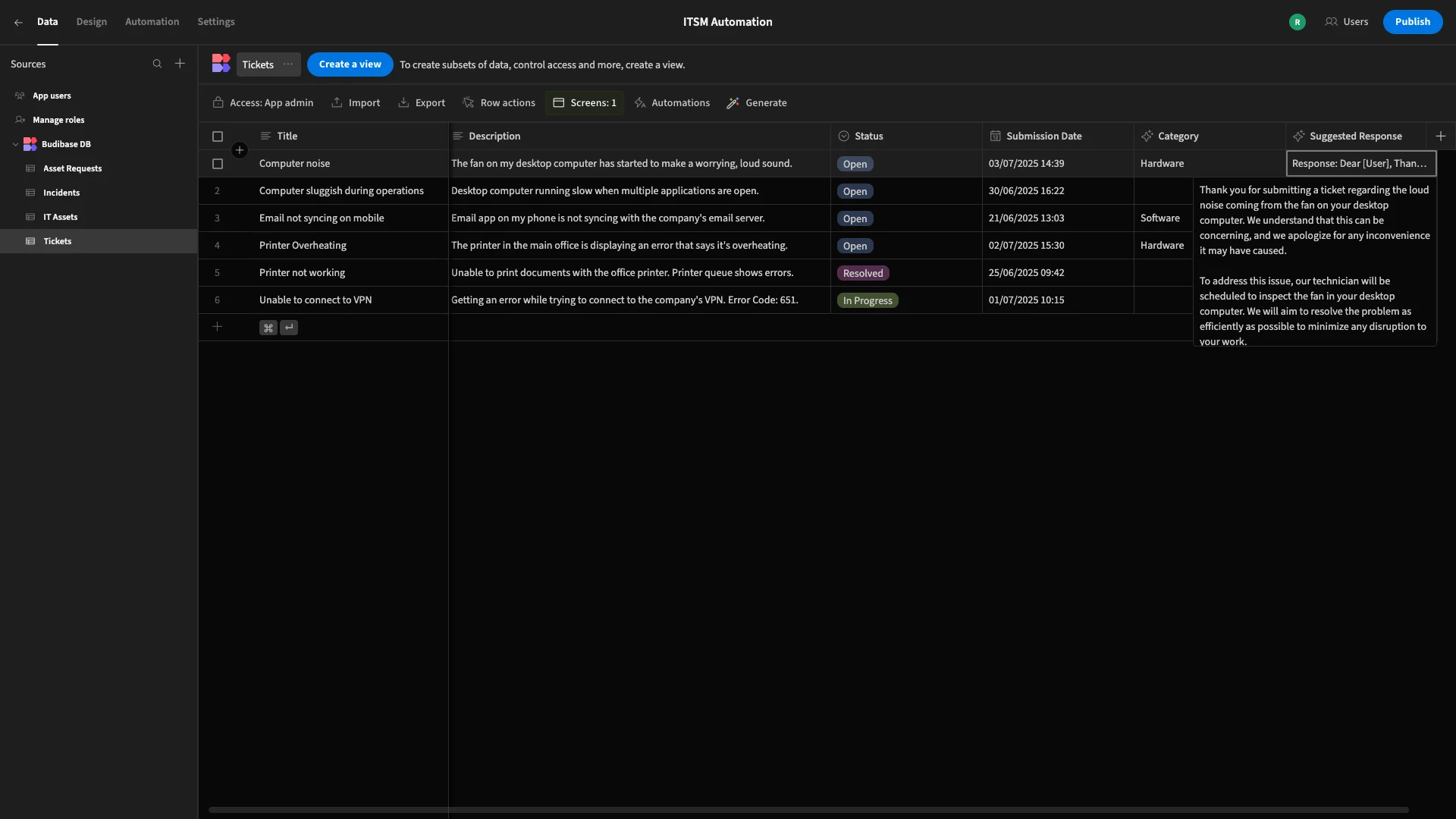
Turn data into action with Budibase
Budibase is the open-source, low-code platform that empowers IT teams to turn data into action.
We offer connectivity for a range of RDBMSs, APIs, NoSQL tools, and LLMs, alongside autogenerated interfaces, a visual automation builder, custom RBAC, optional self-hosting, free SSO, and more.
There’s never been a better way to build professional internal tools at speed. Check out our features overview to learn more.